Kelly Jensen's Blog, page 126
December 11, 2013
"Best of 2013" and "Best of 2012" YA Lists Compared & What We Should Talk About
On Tuesday and yesterday, I looked at the data about this year's "best of" lists, as tallied from School Library Journal, Kirkus, Horn Book, Publishers Weekly, and Library Journal's "Best YA for Adults." I used almost the exact same metrics as I did in 2012, adjusting a bit for new categories and removing a couple I didn't necessarily find that interesting or have enough data to pull together into anything worth looking at.
Because I used the same tally sheet and looked at so many of the same factors, I thought it would be worthwhile to compare what the "best of" lists in 2012 looked like against this year's "best of" lists. Were there any notable differences between the two years? Were there more books considered "best" one year than the other? Was there a big difference in gender representation? What about other factors? If "best of" lists give a snapshot of a year in YA, then what will comparing two consecutive years say about preferences in "best" books? Again, this is all data and nothing conclusive can be said about it, but it is interesting to look and speculate.
In both 2012 and 2013, I used the same criteria to define a YA book. I didn't look at non-fiction, and I didn't include graphic novels in the final results. In both years, I also took Amazon's age rating of the book being for those 12 and older as a standard for "YA fiction."
Range and Spread of Titles Selected
The first thing that caught my attention when looking at the 2013 data was that it seemed like there were far fewer books being labeled "best of" than there were in 2012. Turns out, my suspicions were correct.
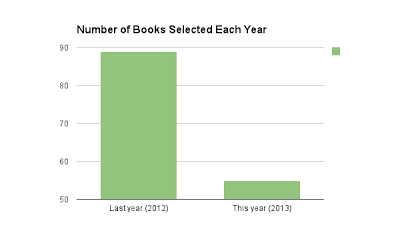
Note that this bar chart begins at 50 and Google won't let me change it to begin at 0. But it shouldn't matter, as it's pretty clear there's a difference in titles selected: last year, there were 89 unique titles on the "best of" lists. This year, there were only 55.
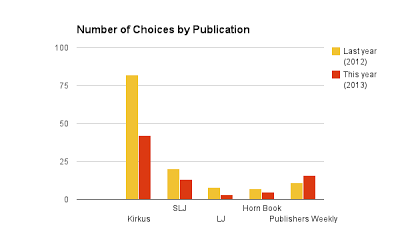
I decided to look at each publication and compare their number of unique choices last year against this year. Every publication selected more YA fiction last year than they did this year, except for Publishers Weekly, which picked 16 titles this year and only 11 last year. There's a big difference in Kirkus's number of choices, where they had selected 82 last year and 42 this year. Repeated titles were included here, as long as it was a unique journal which selected it (in other words, every instance of Far, Far Away counted as an individual title, as long as it was a different journal that picked it).
Even accounting for the non-fiction and graphic novel selections -- which were minimal this year, as well -- there were definitely fewer books selected as "best of" this year.
Does the fewer number of titles being selected as "best of" suggest that maybe this was a weaker year for YA fiction? Or if that's not the case, did fewer books stand out and resonate this year among editors tasked with selecting the bests? Most "best of" lists are decided by vote and by the editors of the journals, and I wonder if there's any correlation between the number of "best of" titles selected and the number of starred reviews earned this year. In other words, did fewer books earn starred reviews in 2013 than in 2012?
Even with Kirkus's more esoteric selections, as discussed yesterday, there seem to be surprisingly few bests this year. Is this a trend we're going to continue to see in the coming years or will 2013 be sort of an outlier?
Author Gender and "Best of" Lists
I didn't keep track of the gender of the main characters in 2012 the way I did in 2013 (part of it having to do with having way more books on the 2012 list), but I did look at the gender of the authors on both sets of lists. For 2012, there were a total of 90 authors and in 2013, there were a total of 55.
In 2012:
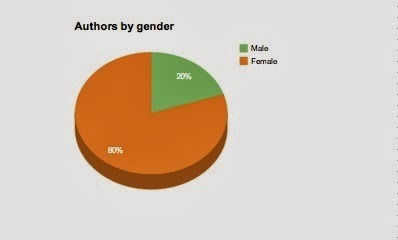
There were 72 females and 18 males.
In 2013:
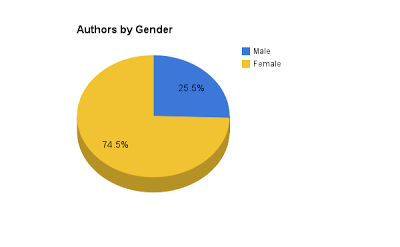
There were 41 females and 14 males.
As can be seen, there was a smaller percentage of female authors in 2013 than there were comparatively in 2012. Eighty percent of the authors in 2012 were female, whereas about 75% were female in 2013.
Although there aren't hard numbers to represent all of the YA books published as categorized by author gender in these years, it does make me wonder a little bit if there were fewer female authors in 2013. Or were there fewer female-written books that stood out as "best?" It's a small percentage drop, of course, but it's an interesting trend, especially when taken in light of the data about the New York Times gender split for their YA list.
Debut Novelists on the "Best of" Lists
Did debut novelists do better in 2012 than they did in 2013 when it comes to being on the "best of" lists? Let's take a look.
In 2012:

There were a total of 18 debut novelists in 2012, which came to 20% of the total number of authors on the "best of" list.
Compare to 2013:
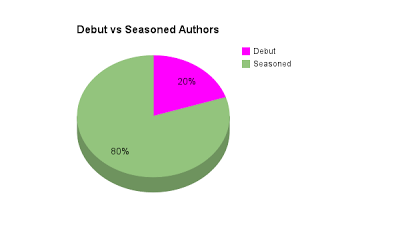 There were 11 debut novelists in 2013, which also equalled a total of 20% of the authors on this year's "best of" lists. In other words, no difference in debut novelists on the lists in the last year.
There were 11 debut novelists in 2013, which also equalled a total of 20% of the authors on this year's "best of" lists. In other words, no difference in debut novelists on the lists in the last year.
Genre Representation in "Best of" Lists
I mentioned that this year, there was a rise in realistic fiction in frequency of appearance on the "best of" lists. I thought it was notable, as the last couple of years have mentioned that realistic fiction would become "the next big thing," and the "best of" lists at least suggested that realistic fiction caught more critical attention this year.
But was there a rise in realistic fiction this year as compared to last year? And if so, what was in abundance last year that maybe didn't show itself as popular among the "best of" lists this year?
Here's the 2012 breakdown:
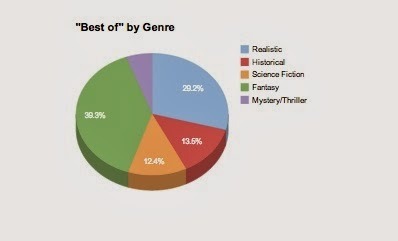
Fantasy took up the largest portion of the "best of" lists, though realistic held its own. Last year, when I did the genre breakdown, I made "mystery and thriller" a separate category, which I did not do this year. I suspect if I were to reconsider categories, many of those books would end up under realistic fiction, thus making it about the same size as fantasy in terms of appearances on the list. Historical and science fiction followed in popularity.
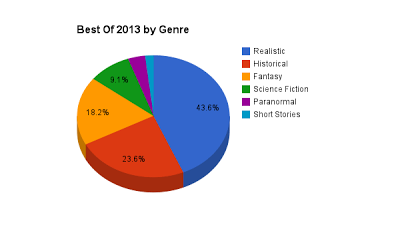 There were more historical novels on this year's "best of" lists than there were in 2012, with roughly 24% of the books falling under that genre. Compare to last year's 14%. But what's most notable is that fantasy dropped sharply this year, at roughly 19%, while in 2012, fantasy occupied almost 40% of the "best of" lists. There were also fewer novels categorized as science fiction that appeared in 2013 than in 2012.
There were more historical novels on this year's "best of" lists than there were in 2012, with roughly 24% of the books falling under that genre. Compare to last year's 14%. But what's most notable is that fantasy dropped sharply this year, at roughly 19%, while in 2012, fantasy occupied almost 40% of the "best of" lists. There were also fewer novels categorized as science fiction that appeared in 2013 than in 2012.
Realistic fiction's presence on the "best of" lists definitely increased, even if the mystery/thriller category is rolled into realistic fiction for 2012's counts. This year, realistic fiction was nearly 44% of the "best of" lists.
Best of by List Frequency
With the fact there were fewer books on this year's "best of" list than in 2012, as well as a shift a bit in terms of genre representation, I thought it would also be worth looking at the frequency of titles appearing across multiple lists. There were 5 lists total, and I was curious whether more books would appear more frequently on lists in 2012 or in 2013.
In 2012, here's what the frequency of books on the "best of" books looked like:
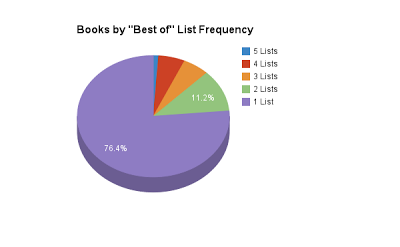 The vast majority of books only showed up on one list, though a good portion also showed up on two lists. Smaller numbers appeared on three and four lists, and there was a single book which appeared on all five of the lists (that went to Elizabeth Wein's Code Name Verity). For the curious, the books which were on four lists each last year were Vaunda Nelson's No Crystal Stair, Margo Lanagan's Brides of Rollrock Island, AS King's Ask the Passengers, John Green's The Fault in Our Stars, and Libba Bray's The Diviners.
The vast majority of books only showed up on one list, though a good portion also showed up on two lists. Smaller numbers appeared on three and four lists, and there was a single book which appeared on all five of the lists (that went to Elizabeth Wein's Code Name Verity). For the curious, the books which were on four lists each last year were Vaunda Nelson's No Crystal Stair, Margo Lanagan's Brides of Rollrock Island, AS King's Ask the Passengers, John Green's The Fault in Our Stars, and Libba Bray's The Diviners.
Compare to 2013:
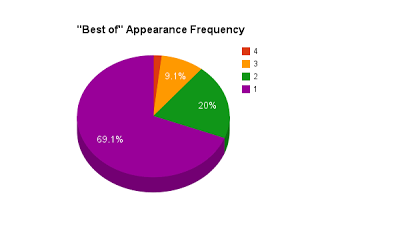 There were a smaller percentage of books appearing on a single list this year than last, but there was a pretty big increase in the percentage of books on two lists, as opposed to one list in 2012. That's percentage-wise, though, of the total number of books across the five lists. Raw numbers show that it was actually only an increase of one book appearing on two lists this year -- 11 in 2013, rather than 10 in 2012. Both years saw a total of five books on three lists, though because of the smaller number of books overall on this year's list, the percentage appears larger.
There were a smaller percentage of books appearing on a single list this year than last, but there was a pretty big increase in the percentage of books on two lists, as opposed to one list in 2012. That's percentage-wise, though, of the total number of books across the five lists. Raw numbers show that it was actually only an increase of one book appearing on two lists this year -- 11 in 2013, rather than 10 in 2012. Both years saw a total of five books on three lists, though because of the smaller number of books overall on this year's list, the percentage appears larger.
As mentioned in a previous data post, there were no books this year that ended up on all five of the "best of" lists (except for Boxers and Saints, which was not included in any of the data because I didn't include it in YA fiction but considered it a graphic novel instead).
So What Does This All Mean?
In the big context of "best of" lists and accolades at the end of any given year in YA fiction, the data doesn't really say a whole lot. It does, however, give us a picture of what a year in YA looks like. This year, it appears we have fewer female authors penning books considered "best of" (though it's still a larger percentage than male authors), and we have many more realistic fiction filling out the lists than other genres.
We have fewer books earning multiple spots on "best of" lists, but with fewer books overall, what does that say? Again, the question I keep circling back to and have from the beginning of looking at this data is how much one list impacts another list and how much marketing may influence these things.
This year felt like a noteworthy one when it came to books being sold to readers and sold to readers in a very big way. There appeared to be a lot more money spent on a lot fewer titles, and I wonder how much of that reflects in these "best of" lists. The more a book is sold as a great book, how much more likely are we to believe that?
Even the most objective readers can't avoid hearing and seeing the buzz about certain books. I'm not suggesting that editorial boards choosing their "best of" are swayed by this kind of marketing, but rather, this kind of marketing really did stick out this year more than other years. Which then leads me to another set of questions that seem to be the ones authors and creative types deal with themselves: do these "best of" list creators stick to their purely objective "best of" picks or do they feel at times pressured to bend to what the popular opinion of the "best of" books might be?
The most popular book this year among the "Best of" selections this year was Rowell's Eleanor & Park. It was a good book.
But this was also a book that received spectacular marketing and publicity. It got a review in the New York Times by John Green, along with five starred reviews. That wasn't lost on the book's marketing, either -- how many places was the book heralded as one that John Green himself loved and that other readers would, too? It was SMART. It helped a new YA author, who had only published one book into the adult market prior, gain immense traction and attention very quickly (it didn't hurt the attention Rowell's second book out this year received, either, as we were reminded that Green loved her first book in the marketing there, too). Readers have fallen in love with Eleanor & Park over and over, and it showed up on nearly every list this year where adult readers were told it's okay to read YA because of books like that.
Was it this year's "best" book? Would this book be seen as this good were it not for all of the marketing behind it? What about without all of the adult praise it earned (you know, it's a "YA book that is okay for grown ups to read")? This book was impossible to avoid, whether you were a YA reader or you weren't a YA reader.
It's hard not to think about the other books that came out this year that were as good as Rowell's. But what were they? Are they some of those books Kirkus called out that, yesterday, I questioned as to why they were on the list in the first place? Have I become accustomed to thinking that outliers on these lists indicate a poor choice? Or is Kirkus on to something I'm unaware of because those books have yet to be sold and marketed to me as a reader (or more accurately, as a librarian who buys these books and then sells them to teen readers)?
The smaller the field of "bests," the more I wonder what was overlooked simply because a few big titles had so much weight behind them.
Of course I have no answers. I just have a lot more questions, and they're the kinds of questions I like to end a year with because they make me reevaluate my own reading, my own means of book recommendation, and my own personal "favorite" or "best of" lists. How much farther out do I want to reach to find hidden gems? How many of the big books should I make sure I do read because maybe I am missing something big there, too?
As of this writing, I haven't yet seen the Booklist nor the BCCB "best of" lists, and I'm curious how those will stack up against these lists. Likewise, what will YALSA committees select as best books with their Printz this year, their Quick Picks, or their Best Fiction for Young Adults?
I'd love thoughts and ideas regarding this year's best of picks, especially as they compare to last year's. Any thoughts? Do you have any books you wish had seen time on the "best of" lists that didn't show up? What about books that appeared on the list that make you scratch your head a bit?






 Related Stories"Best of 2013" YA List Breakdown, Part 2"Best of 2013 YA" List Breakdown, Part 1November and December Debut YA Novels
Related Stories"Best of 2013" YA List Breakdown, Part 2"Best of 2013 YA" List Breakdown, Part 1November and December Debut YA Novels
Because I used the same tally sheet and looked at so many of the same factors, I thought it would be worthwhile to compare what the "best of" lists in 2012 looked like against this year's "best of" lists. Were there any notable differences between the two years? Were there more books considered "best" one year than the other? Was there a big difference in gender representation? What about other factors? If "best of" lists give a snapshot of a year in YA, then what will comparing two consecutive years say about preferences in "best" books? Again, this is all data and nothing conclusive can be said about it, but it is interesting to look and speculate.
In both 2012 and 2013, I used the same criteria to define a YA book. I didn't look at non-fiction, and I didn't include graphic novels in the final results. In both years, I also took Amazon's age rating of the book being for those 12 and older as a standard for "YA fiction."
Range and Spread of Titles Selected
The first thing that caught my attention when looking at the 2013 data was that it seemed like there were far fewer books being labeled "best of" than there were in 2012. Turns out, my suspicions were correct.

Note that this bar chart begins at 50 and Google won't let me change it to begin at 0. But it shouldn't matter, as it's pretty clear there's a difference in titles selected: last year, there were 89 unique titles on the "best of" lists. This year, there were only 55.

I decided to look at each publication and compare their number of unique choices last year against this year. Every publication selected more YA fiction last year than they did this year, except for Publishers Weekly, which picked 16 titles this year and only 11 last year. There's a big difference in Kirkus's number of choices, where they had selected 82 last year and 42 this year. Repeated titles were included here, as long as it was a unique journal which selected it (in other words, every instance of Far, Far Away counted as an individual title, as long as it was a different journal that picked it).
Even accounting for the non-fiction and graphic novel selections -- which were minimal this year, as well -- there were definitely fewer books selected as "best of" this year.
Does the fewer number of titles being selected as "best of" suggest that maybe this was a weaker year for YA fiction? Or if that's not the case, did fewer books stand out and resonate this year among editors tasked with selecting the bests? Most "best of" lists are decided by vote and by the editors of the journals, and I wonder if there's any correlation between the number of "best of" titles selected and the number of starred reviews earned this year. In other words, did fewer books earn starred reviews in 2013 than in 2012?
Even with Kirkus's more esoteric selections, as discussed yesterday, there seem to be surprisingly few bests this year. Is this a trend we're going to continue to see in the coming years or will 2013 be sort of an outlier?
Author Gender and "Best of" Lists
I didn't keep track of the gender of the main characters in 2012 the way I did in 2013 (part of it having to do with having way more books on the 2012 list), but I did look at the gender of the authors on both sets of lists. For 2012, there were a total of 90 authors and in 2013, there were a total of 55.
In 2012:

There were 72 females and 18 males.
In 2013:

There were 41 females and 14 males.
As can be seen, there was a smaller percentage of female authors in 2013 than there were comparatively in 2012. Eighty percent of the authors in 2012 were female, whereas about 75% were female in 2013.
Although there aren't hard numbers to represent all of the YA books published as categorized by author gender in these years, it does make me wonder a little bit if there were fewer female authors in 2013. Or were there fewer female-written books that stood out as "best?" It's a small percentage drop, of course, but it's an interesting trend, especially when taken in light of the data about the New York Times gender split for their YA list.
Debut Novelists on the "Best of" Lists
Did debut novelists do better in 2012 than they did in 2013 when it comes to being on the "best of" lists? Let's take a look.
In 2012:
There were a total of 18 debut novelists in 2012, which came to 20% of the total number of authors on the "best of" list.
Compare to 2013:
 There were 11 debut novelists in 2013, which also equalled a total of 20% of the authors on this year's "best of" lists. In other words, no difference in debut novelists on the lists in the last year.
There were 11 debut novelists in 2013, which also equalled a total of 20% of the authors on this year's "best of" lists. In other words, no difference in debut novelists on the lists in the last year.Genre Representation in "Best of" Lists
I mentioned that this year, there was a rise in realistic fiction in frequency of appearance on the "best of" lists. I thought it was notable, as the last couple of years have mentioned that realistic fiction would become "the next big thing," and the "best of" lists at least suggested that realistic fiction caught more critical attention this year.
But was there a rise in realistic fiction this year as compared to last year? And if so, what was in abundance last year that maybe didn't show itself as popular among the "best of" lists this year?
Here's the 2012 breakdown:

Fantasy took up the largest portion of the "best of" lists, though realistic held its own. Last year, when I did the genre breakdown, I made "mystery and thriller" a separate category, which I did not do this year. I suspect if I were to reconsider categories, many of those books would end up under realistic fiction, thus making it about the same size as fantasy in terms of appearances on the list. Historical and science fiction followed in popularity.
 There were more historical novels on this year's "best of" lists than there were in 2012, with roughly 24% of the books falling under that genre. Compare to last year's 14%. But what's most notable is that fantasy dropped sharply this year, at roughly 19%, while in 2012, fantasy occupied almost 40% of the "best of" lists. There were also fewer novels categorized as science fiction that appeared in 2013 than in 2012.
There were more historical novels on this year's "best of" lists than there were in 2012, with roughly 24% of the books falling under that genre. Compare to last year's 14%. But what's most notable is that fantasy dropped sharply this year, at roughly 19%, while in 2012, fantasy occupied almost 40% of the "best of" lists. There were also fewer novels categorized as science fiction that appeared in 2013 than in 2012.Realistic fiction's presence on the "best of" lists definitely increased, even if the mystery/thriller category is rolled into realistic fiction for 2012's counts. This year, realistic fiction was nearly 44% of the "best of" lists.
Best of by List Frequency
With the fact there were fewer books on this year's "best of" list than in 2012, as well as a shift a bit in terms of genre representation, I thought it would also be worth looking at the frequency of titles appearing across multiple lists. There were 5 lists total, and I was curious whether more books would appear more frequently on lists in 2012 or in 2013.
In 2012, here's what the frequency of books on the "best of" books looked like:
 The vast majority of books only showed up on one list, though a good portion also showed up on two lists. Smaller numbers appeared on three and four lists, and there was a single book which appeared on all five of the lists (that went to Elizabeth Wein's Code Name Verity). For the curious, the books which were on four lists each last year were Vaunda Nelson's No Crystal Stair, Margo Lanagan's Brides of Rollrock Island, AS King's Ask the Passengers, John Green's The Fault in Our Stars, and Libba Bray's The Diviners.
The vast majority of books only showed up on one list, though a good portion also showed up on two lists. Smaller numbers appeared on three and four lists, and there was a single book which appeared on all five of the lists (that went to Elizabeth Wein's Code Name Verity). For the curious, the books which were on four lists each last year were Vaunda Nelson's No Crystal Stair, Margo Lanagan's Brides of Rollrock Island, AS King's Ask the Passengers, John Green's The Fault in Our Stars, and Libba Bray's The Diviners.Compare to 2013:
 There were a smaller percentage of books appearing on a single list this year than last, but there was a pretty big increase in the percentage of books on two lists, as opposed to one list in 2012. That's percentage-wise, though, of the total number of books across the five lists. Raw numbers show that it was actually only an increase of one book appearing on two lists this year -- 11 in 2013, rather than 10 in 2012. Both years saw a total of five books on three lists, though because of the smaller number of books overall on this year's list, the percentage appears larger.
There were a smaller percentage of books appearing on a single list this year than last, but there was a pretty big increase in the percentage of books on two lists, as opposed to one list in 2012. That's percentage-wise, though, of the total number of books across the five lists. Raw numbers show that it was actually only an increase of one book appearing on two lists this year -- 11 in 2013, rather than 10 in 2012. Both years saw a total of five books on three lists, though because of the smaller number of books overall on this year's list, the percentage appears larger.As mentioned in a previous data post, there were no books this year that ended up on all five of the "best of" lists (except for Boxers and Saints, which was not included in any of the data because I didn't include it in YA fiction but considered it a graphic novel instead).
So What Does This All Mean?
In the big context of "best of" lists and accolades at the end of any given year in YA fiction, the data doesn't really say a whole lot. It does, however, give us a picture of what a year in YA looks like. This year, it appears we have fewer female authors penning books considered "best of" (though it's still a larger percentage than male authors), and we have many more realistic fiction filling out the lists than other genres.
We have fewer books earning multiple spots on "best of" lists, but with fewer books overall, what does that say? Again, the question I keep circling back to and have from the beginning of looking at this data is how much one list impacts another list and how much marketing may influence these things.
This year felt like a noteworthy one when it came to books being sold to readers and sold to readers in a very big way. There appeared to be a lot more money spent on a lot fewer titles, and I wonder how much of that reflects in these "best of" lists. The more a book is sold as a great book, how much more likely are we to believe that?
Even the most objective readers can't avoid hearing and seeing the buzz about certain books. I'm not suggesting that editorial boards choosing their "best of" are swayed by this kind of marketing, but rather, this kind of marketing really did stick out this year more than other years. Which then leads me to another set of questions that seem to be the ones authors and creative types deal with themselves: do these "best of" list creators stick to their purely objective "best of" picks or do they feel at times pressured to bend to what the popular opinion of the "best of" books might be?
The most popular book this year among the "Best of" selections this year was Rowell's Eleanor & Park. It was a good book.
But this was also a book that received spectacular marketing and publicity. It got a review in the New York Times by John Green, along with five starred reviews. That wasn't lost on the book's marketing, either -- how many places was the book heralded as one that John Green himself loved and that other readers would, too? It was SMART. It helped a new YA author, who had only published one book into the adult market prior, gain immense traction and attention very quickly (it didn't hurt the attention Rowell's second book out this year received, either, as we were reminded that Green loved her first book in the marketing there, too). Readers have fallen in love with Eleanor & Park over and over, and it showed up on nearly every list this year where adult readers were told it's okay to read YA because of books like that.
Was it this year's "best" book? Would this book be seen as this good were it not for all of the marketing behind it? What about without all of the adult praise it earned (you know, it's a "YA book that is okay for grown ups to read")? This book was impossible to avoid, whether you were a YA reader or you weren't a YA reader.
It's hard not to think about the other books that came out this year that were as good as Rowell's. But what were they? Are they some of those books Kirkus called out that, yesterday, I questioned as to why they were on the list in the first place? Have I become accustomed to thinking that outliers on these lists indicate a poor choice? Or is Kirkus on to something I'm unaware of because those books have yet to be sold and marketed to me as a reader (or more accurately, as a librarian who buys these books and then sells them to teen readers)?
The smaller the field of "bests," the more I wonder what was overlooked simply because a few big titles had so much weight behind them.
Of course I have no answers. I just have a lot more questions, and they're the kinds of questions I like to end a year with because they make me reevaluate my own reading, my own means of book recommendation, and my own personal "favorite" or "best of" lists. How much farther out do I want to reach to find hidden gems? How many of the big books should I make sure I do read because maybe I am missing something big there, too?
As of this writing, I haven't yet seen the Booklist nor the BCCB "best of" lists, and I'm curious how those will stack up against these lists. Likewise, what will YALSA committees select as best books with their Printz this year, their Quick Picks, or their Best Fiction for Young Adults?
I'd love thoughts and ideas regarding this year's best of picks, especially as they compare to last year's. Any thoughts? Do you have any books you wish had seen time on the "best of" lists that didn't show up? What about books that appeared on the list that make you scratch your head a bit?







 Related Stories"Best of 2013" YA List Breakdown, Part 2"Best of 2013 YA" List Breakdown, Part 1November and December Debut YA Novels
Related Stories"Best of 2013" YA List Breakdown, Part 2"Best of 2013 YA" List Breakdown, Part 1November and December Debut YA Novels
Published on December 11, 2013 22:00
December 10, 2013
"Best of 2013" YA List Breakdown, Part 2
This is part two of this year's "best of YA" list breakdown. Make sure you read yesterday's post, or at least the introduction of it, to understand why and how this works. To summarize the key points and to make sense of today's data, I'll repeat some of the important details: none of the data presented here is meant to "prove" anything. It's presented in order to offer some discussion points, to explore trends and themes within the books deemed as the "best" of this year's YA fiction, and any errors in data tabulation are mine and mine alone (and hopefully, there are few, if none!).
All data is based on 55 book titles, 55 authors, and in situations where discussion turns to main characters in a book, there are 62 identified main characters. All of the data is pulled from five "best of" lists: School Library Journal, Kirkus, Horn Book, Library Journal's "YA for Adults," and Publishers Weekly.
I thought it would be interesting to break down the lists into less "big picture" stuff and into smaller picture stuff. Where yesterday looked at things like presence of books featuring POC or LGBTQ characters, as well as gender breakdowns of both authors and main characters, today I wanted to look at more granular list data. All of my raw data can be accessed here. It's not necessarily pretty, but I'm happy if people want to use it to draw additional connections between and among "best of" titles. Some of the information I included on the chart did not make my blog posts (there was too little to talk about in terms of print run, genre, and gender, especially compared to last year) and some of it will appear in tomorrow's comparison post between 2012 "best of" lists and this year's "best of" lists.
So with that, let's dig in.
Month of Publication
Were books published earlier in the year more likely than those published later in the year to make the "best of" lists? Or, because their newness and shininess wore off prior to decision-making time, were they less likely to make the lists?
When it came to books published in the first half of the year (January - June) against those which published in the second half of the year (July - December), here's the breakdown:
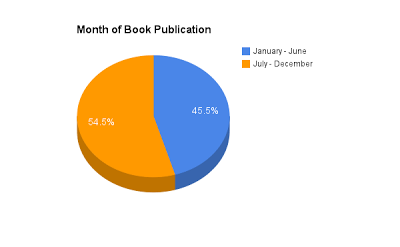
"Best of" books published between January and June came to 25 total titles, while those published between July and December equalled 30. There's not a major difference between representation of titles in the first half of the year and those in the second half.
What about breaking it down more? Is there a month where more "best of" books were published? The answer to this one is yes.
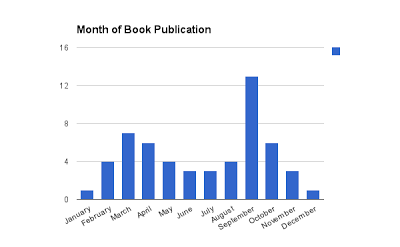
The leader of the pack this year is September -- thirteen of the books on this year's "best of" lists were published that month. March had the second highest number of books on the lists, with 7, followed by October and April with six each.
Worth noting in this data is something I'm trying to better understand. On Kirkus's list, one of the books listed (Nowhere to Run by Claire Griffin) appeared to have numerous publication dates, according to Amazon's various listings. It was difficult to parse out whether this book was actually published this year or was published last year, since I saw a November 2012 date, as well as a March 2013 date. Kirkus made a handful of choices this year which didn't make perfect sense to me, and I can't help wonder if maybe that 2012 publication date was accurate. Either way, I operated as though the book was published in March of this year.
What about the month of publication for those debut authors? Was there a better month to be a debut author and end up on the "best of" lists?
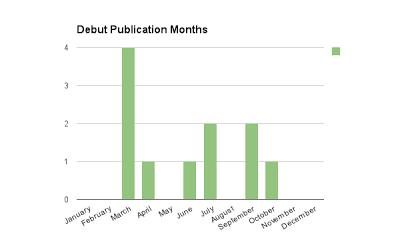
There were four debut novels on the "best of" list published in March, followed by two in July and September. April, June, and October had one each.
Publication Format
I'm always curious whether hardcovers or paperback originals do better on the "best of" lists. There seem to be fewer paperback originals published in YA than hardcovers, but it's a category I still like looking at. If there is data on this at all, I would love to know about it.
One thing I wanted to point out in this data was something that interested me with the Kirkus list. One of their titles, Outcast Oracle, appears not to be for sale in a non-e-book format in the general market. I checked both Amazon and Barnes and Noble and it's only available for purchase as a Kindle or Nook book. I went to the publisher's website to see if there was indeed a print run at all, and it appears you can buy a paperback copy from the publisher directly. I also hopped onto Baker & Taylor, which is where my library purchases its books (and where a large percentage of public libraries make their purchases) and the book is not available on there in any format.
Which makes me wonder a little bit about how valuable that title being on the list is, since getting access to it is such a hurdle. You either need an ereader OR you need to purchase direct from the publisher. Will having it on this list give it a bump in sales or encourage an easy way to purchase it? I'll talk a little bit more about this tomorrow, since it's fascinating to me what including this particular title might suggest.
But back to the category at hand: I looked at hardcover books, paperback originals (which is where I stuck the title above), and those books which feature a split run, where both a hardcover and a paperback are published simultaneously.
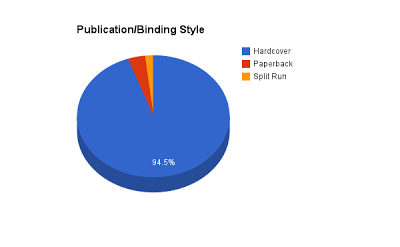
There's no question that hardcover format dominated the "best of" lists, with 52 of the titles published as hardcover. Two books were published as paperback originals, which included both the title noted above, as well as Kelsey Sutton's Some Quiet Place. One book appeared to be a split run, which was the previously noted Nowhere to Run by Claire Griffin.
Were there fewer paperback originals published this year? Fewer split runs? Of course, some publishers only do paperback originals (like Flux) and some publishers make it clear their "bigger" titles are hardcover. I've yet to figure out what it means when a book is published as split, if anything (this year, a few books that were published split run but weren't on the "best of" lists include Jody Casella's The Thin Space, Sarah McCarry's All Our Pretty Songs, and Hannah Moskowitz's Teeth).
Publisher Representation on the "Best Of" Lists
Are there publishers which tend to do better on the "best of" lists? I've always had it in my mind that some publishers work on books that are less mainstream, a little riskier, and that those books do tend to be noticed on the end-of-year lists for those things. Candlewick is perhaps the one which stands out most in my mind for this, as well as Lerner/Carolrhoda LAB.
I've flattened all of the imprints into their respective publishers for simplicity's sake (so, St. Martin's titles are under Macmillan), and because I wanted it to be readable, I broke it into two charts. Here's a look at how the various publishers did on the "best of" lists:
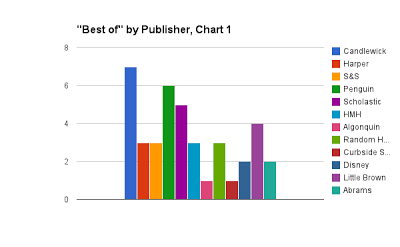
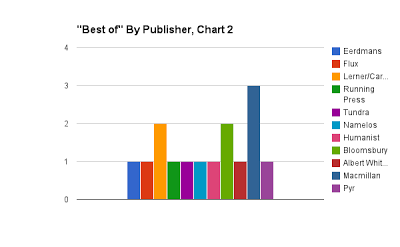
I purposefully didn't do it in a decline since that would mess up the scaling on the charts themselves and I wanted these to be as close to the same scale as possible. But as you can see, Candlewick led the publishers with the most books on the "best of" lists, with a total of 7 titles. Penguin had 6, with 5 titles from Scholastic, 4 from Little, Brown, and 3 each from Harper, Macmillan, Simon & Schuster, and Houghton Mifflin.
As should be clear, there are a lot of titles on the "best of" list not published by a Big 6/5 publisher (so, not a book published by Harper, Little, Brown, Simon & Schuster, Macmillan, Penguin/Random House). Comparatively, mid/small/indie presses had more titles on these lists: 33 of the books on the "best of" list came from non-Big 6/5 publishers, while 22 did.
I think this is pretty impressive, especially with Candlewick's large presence. Carolrhoda LAB had two titles, which is also impressive given how small their seasonal lists are.
"Best of" Lists and Starred Reviews Earned
Since we know the "best of" books now, is it fair to assume that books which appeared more frequently on the lists tended to have more starred reviews in the six major review journals?
I pulled the starred reviews from ShelfTalker's round up of "The Stars So Far" in November. I looked at stars earned from the following publications: BCCB, Booklist, Kirkus, SLJ, PW, and Horn Book. Of course, there's a lot of leeway and error that can happen here. Not all journals will review all books. Not all journals review the books in a timely fashion, and so there's a possibility that some of these books will earn stars later.
Not a single one of the YA novels I looked at had earned stars from all six of those publications, either.
Among the "best of" books, here's how the starred reviews broke down:
Seven books earned 5 starred reviewsFour Books earned 4 starred reviewsThirteen books earned 3 starred reviewsFourteen books earned 2 starred reviewsSixteen books earned 1 starred review
The breakdown doesn't surprise me a whole lot, especially because the majority of the books on the "best of" lists came from Kirkus's list, and they tended to have earned a star from Kirkus. In other words, a lot of single-starred books were the books Kirkus selected as "best" (though certainly not all).
So what about starred review frequency against the frequency to which books appeared on "best of" lists? Here's the chart:
List Appearances vs. Star Earnings5 lists4 lists3 lists2 lists1 list6 stars000005 stars012314 stars001403 stars0012102 stars0012111 star000016
Again, no books made all five lists, and the bulk of the books fell into the category of landing on one list and earning one, two, or three stars.
Eleanor & Park, the book with the most placements on the "best of" lists this year, earned five starred reviews.
Series vs. Stand Alone Titles on the "Best of" Lists
To wrap up the data, let's look at a simple but worthwhile aspect: do series books do better or worse than stand alone titles on the "best of" lists? This is, I think, impacted pretty significantly by genre of the "best of" books this year, since realistic fiction tends to produce fewer series books than other genres.
In this data, I included companion and prequels as "series" books (so Rose Under Fire and Invasion were rolled into that data).
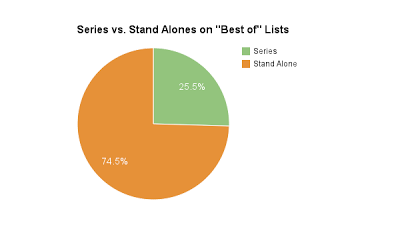
Roughly one quarter of the "best of" lists were series books, while three-quarters were stand alone titles. Of those books which were part of a series, there were:two prequelsone companionsix were the first in a seriesthree were the second book in a seriestwo that were third books.
Some Concluding Thoughts on the 2013 Data
While I've commented throughout on what I think the takeaways or questions are about the data and "best of" lists this year, I did have a couple of other thoughts to share, and I would love if anyone wanted to weigh in on what they've seen. I have one final post coming tomorrow that will compare this year's data with last year's, which I think will spark some interesting conversation.
First, it's worth noting that Kirkus's list is the lengthiest again this year, and it's also the most strange. I'm confused by their inclusion of a novel that has been categorized in numerous places, including the publisher's own catalog, as "middle grade." That's Fireborn by Toby Forward. Because Amazon listed the age range as 12 and older, I did include it all of the data, but since it's a book not published until after the "best of" appeared, I'll be curious what readers and other critics say is the true age range. To me, it even looks middle grade.
Likewise, Kirkus included more indie press titles (note self-published, but actual indie press) than other publications did. This led me to some of the questions above about Outcast Oracle and it makes me question who their list might be intended for. Any reader who spent time with their list likewise probably noticed it was difficult to parse out their picks from the paid-for advertising of books between their selections, too. If there are more and more titles being selected as "best of" that are difficult to acquire for, say, purchasers at institutions, it makes me wonder how much value the list itself has for users like myself, a librarian who does sometimes supplement collections with titles I may have missed. If it's a book I cannot get without jumping through hoops, though, why bother?
On the other hand, the more esoteric choices make me wonder how many gems slip through the cracks each year because they are from smaller presses. Right now, I think we might have a dark horse for YALSA awards, as well as an under-sung gem Chris L. Terry's Zero Fade.
Overall, this year's list had a much smaller range of titles than I thought. Is it because this is a weaker year for YA overall or do the lists have an unintentional (or intentional) impact on one another? Horn Book, for example, only had 5 YA titles included in their "best of," and LJ's "YA for Adults" only had three by the criteria I used.
There's nothing that can be said conclusively, of course. But what makes "best of" lists interesting to look at as data, rather than as something more subjective, is that it lets you consider the year in a snapshot. This might have been a weaker YA year. It may have been the year that male main characters were stronger than female. It may have continued a trend of featuring a small number of LGBTQ characters. It's also interesting to consider what this "best of" snapshot will indicate in the future, too. Will we have more books of a certain ilk because they're more likely to perform better?
Stick around for tomorrow's thoughts and comparisons between this year's list and last year's. Although again it won't make any hard conclusions, it can shed some insight into some of these questions.






 Related Stories"Best of 2013 YA" List Breakdown, Part 1November and December Debut YA NovelsThe To-Read Pile
Related Stories"Best of 2013 YA" List Breakdown, Part 1November and December Debut YA NovelsThe To-Read Pile
All data is based on 55 book titles, 55 authors, and in situations where discussion turns to main characters in a book, there are 62 identified main characters. All of the data is pulled from five "best of" lists: School Library Journal, Kirkus, Horn Book, Library Journal's "YA for Adults," and Publishers Weekly.
I thought it would be interesting to break down the lists into less "big picture" stuff and into smaller picture stuff. Where yesterday looked at things like presence of books featuring POC or LGBTQ characters, as well as gender breakdowns of both authors and main characters, today I wanted to look at more granular list data. All of my raw data can be accessed here. It's not necessarily pretty, but I'm happy if people want to use it to draw additional connections between and among "best of" titles. Some of the information I included on the chart did not make my blog posts (there was too little to talk about in terms of print run, genre, and gender, especially compared to last year) and some of it will appear in tomorrow's comparison post between 2012 "best of" lists and this year's "best of" lists.
So with that, let's dig in.
Month of Publication
Were books published earlier in the year more likely than those published later in the year to make the "best of" lists? Or, because their newness and shininess wore off prior to decision-making time, were they less likely to make the lists?
When it came to books published in the first half of the year (January - June) against those which published in the second half of the year (July - December), here's the breakdown:

"Best of" books published between January and June came to 25 total titles, while those published between July and December equalled 30. There's not a major difference between representation of titles in the first half of the year and those in the second half.
What about breaking it down more? Is there a month where more "best of" books were published? The answer to this one is yes.

The leader of the pack this year is September -- thirteen of the books on this year's "best of" lists were published that month. March had the second highest number of books on the lists, with 7, followed by October and April with six each.
Worth noting in this data is something I'm trying to better understand. On Kirkus's list, one of the books listed (Nowhere to Run by Claire Griffin) appeared to have numerous publication dates, according to Amazon's various listings. It was difficult to parse out whether this book was actually published this year or was published last year, since I saw a November 2012 date, as well as a March 2013 date. Kirkus made a handful of choices this year which didn't make perfect sense to me, and I can't help wonder if maybe that 2012 publication date was accurate. Either way, I operated as though the book was published in March of this year.
What about the month of publication for those debut authors? Was there a better month to be a debut author and end up on the "best of" lists?

There were four debut novels on the "best of" list published in March, followed by two in July and September. April, June, and October had one each.
Publication Format
I'm always curious whether hardcovers or paperback originals do better on the "best of" lists. There seem to be fewer paperback originals published in YA than hardcovers, but it's a category I still like looking at. If there is data on this at all, I would love to know about it.
One thing I wanted to point out in this data was something that interested me with the Kirkus list. One of their titles, Outcast Oracle, appears not to be for sale in a non-e-book format in the general market. I checked both Amazon and Barnes and Noble and it's only available for purchase as a Kindle or Nook book. I went to the publisher's website to see if there was indeed a print run at all, and it appears you can buy a paperback copy from the publisher directly. I also hopped onto Baker & Taylor, which is where my library purchases its books (and where a large percentage of public libraries make their purchases) and the book is not available on there in any format.
Which makes me wonder a little bit about how valuable that title being on the list is, since getting access to it is such a hurdle. You either need an ereader OR you need to purchase direct from the publisher. Will having it on this list give it a bump in sales or encourage an easy way to purchase it? I'll talk a little bit more about this tomorrow, since it's fascinating to me what including this particular title might suggest.
But back to the category at hand: I looked at hardcover books, paperback originals (which is where I stuck the title above), and those books which feature a split run, where both a hardcover and a paperback are published simultaneously.

There's no question that hardcover format dominated the "best of" lists, with 52 of the titles published as hardcover. Two books were published as paperback originals, which included both the title noted above, as well as Kelsey Sutton's Some Quiet Place. One book appeared to be a split run, which was the previously noted Nowhere to Run by Claire Griffin.
Were there fewer paperback originals published this year? Fewer split runs? Of course, some publishers only do paperback originals (like Flux) and some publishers make it clear their "bigger" titles are hardcover. I've yet to figure out what it means when a book is published as split, if anything (this year, a few books that were published split run but weren't on the "best of" lists include Jody Casella's The Thin Space, Sarah McCarry's All Our Pretty Songs, and Hannah Moskowitz's Teeth).
Publisher Representation on the "Best Of" Lists
Are there publishers which tend to do better on the "best of" lists? I've always had it in my mind that some publishers work on books that are less mainstream, a little riskier, and that those books do tend to be noticed on the end-of-year lists for those things. Candlewick is perhaps the one which stands out most in my mind for this, as well as Lerner/Carolrhoda LAB.
I've flattened all of the imprints into their respective publishers for simplicity's sake (so, St. Martin's titles are under Macmillan), and because I wanted it to be readable, I broke it into two charts. Here's a look at how the various publishers did on the "best of" lists:


I purposefully didn't do it in a decline since that would mess up the scaling on the charts themselves and I wanted these to be as close to the same scale as possible. But as you can see, Candlewick led the publishers with the most books on the "best of" lists, with a total of 7 titles. Penguin had 6, with 5 titles from Scholastic, 4 from Little, Brown, and 3 each from Harper, Macmillan, Simon & Schuster, and Houghton Mifflin.
As should be clear, there are a lot of titles on the "best of" list not published by a Big 6/5 publisher (so, not a book published by Harper, Little, Brown, Simon & Schuster, Macmillan, Penguin/Random House). Comparatively, mid/small/indie presses had more titles on these lists: 33 of the books on the "best of" list came from non-Big 6/5 publishers, while 22 did.
I think this is pretty impressive, especially with Candlewick's large presence. Carolrhoda LAB had two titles, which is also impressive given how small their seasonal lists are.
"Best of" Lists and Starred Reviews Earned
Since we know the "best of" books now, is it fair to assume that books which appeared more frequently on the lists tended to have more starred reviews in the six major review journals?
I pulled the starred reviews from ShelfTalker's round up of "The Stars So Far" in November. I looked at stars earned from the following publications: BCCB, Booklist, Kirkus, SLJ, PW, and Horn Book. Of course, there's a lot of leeway and error that can happen here. Not all journals will review all books. Not all journals review the books in a timely fashion, and so there's a possibility that some of these books will earn stars later.
Not a single one of the YA novels I looked at had earned stars from all six of those publications, either.
Among the "best of" books, here's how the starred reviews broke down:
Seven books earned 5 starred reviewsFour Books earned 4 starred reviewsThirteen books earned 3 starred reviewsFourteen books earned 2 starred reviewsSixteen books earned 1 starred review
The breakdown doesn't surprise me a whole lot, especially because the majority of the books on the "best of" lists came from Kirkus's list, and they tended to have earned a star from Kirkus. In other words, a lot of single-starred books were the books Kirkus selected as "best" (though certainly not all).
So what about starred review frequency against the frequency to which books appeared on "best of" lists? Here's the chart:
List Appearances vs. Star Earnings5 lists4 lists3 lists2 lists1 list6 stars000005 stars012314 stars001403 stars0012102 stars0012111 star000016
Again, no books made all five lists, and the bulk of the books fell into the category of landing on one list and earning one, two, or three stars.
Eleanor & Park, the book with the most placements on the "best of" lists this year, earned five starred reviews.
Series vs. Stand Alone Titles on the "Best of" Lists
To wrap up the data, let's look at a simple but worthwhile aspect: do series books do better or worse than stand alone titles on the "best of" lists? This is, I think, impacted pretty significantly by genre of the "best of" books this year, since realistic fiction tends to produce fewer series books than other genres.
In this data, I included companion and prequels as "series" books (so Rose Under Fire and Invasion were rolled into that data).

Roughly one quarter of the "best of" lists were series books, while three-quarters were stand alone titles. Of those books which were part of a series, there were:two prequelsone companionsix were the first in a seriesthree were the second book in a seriestwo that were third books.
Some Concluding Thoughts on the 2013 Data
While I've commented throughout on what I think the takeaways or questions are about the data and "best of" lists this year, I did have a couple of other thoughts to share, and I would love if anyone wanted to weigh in on what they've seen. I have one final post coming tomorrow that will compare this year's data with last year's, which I think will spark some interesting conversation.
First, it's worth noting that Kirkus's list is the lengthiest again this year, and it's also the most strange. I'm confused by their inclusion of a novel that has been categorized in numerous places, including the publisher's own catalog, as "middle grade." That's Fireborn by Toby Forward. Because Amazon listed the age range as 12 and older, I did include it all of the data, but since it's a book not published until after the "best of" appeared, I'll be curious what readers and other critics say is the true age range. To me, it even looks middle grade.
Likewise, Kirkus included more indie press titles (note self-published, but actual indie press) than other publications did. This led me to some of the questions above about Outcast Oracle and it makes me question who their list might be intended for. Any reader who spent time with their list likewise probably noticed it was difficult to parse out their picks from the paid-for advertising of books between their selections, too. If there are more and more titles being selected as "best of" that are difficult to acquire for, say, purchasers at institutions, it makes me wonder how much value the list itself has for users like myself, a librarian who does sometimes supplement collections with titles I may have missed. If it's a book I cannot get without jumping through hoops, though, why bother?
On the other hand, the more esoteric choices make me wonder how many gems slip through the cracks each year because they are from smaller presses. Right now, I think we might have a dark horse for YALSA awards, as well as an under-sung gem Chris L. Terry's Zero Fade.
Overall, this year's list had a much smaller range of titles than I thought. Is it because this is a weaker year for YA overall or do the lists have an unintentional (or intentional) impact on one another? Horn Book, for example, only had 5 YA titles included in their "best of," and LJ's "YA for Adults" only had three by the criteria I used.
There's nothing that can be said conclusively, of course. But what makes "best of" lists interesting to look at as data, rather than as something more subjective, is that it lets you consider the year in a snapshot. This might have been a weaker YA year. It may have been the year that male main characters were stronger than female. It may have continued a trend of featuring a small number of LGBTQ characters. It's also interesting to consider what this "best of" snapshot will indicate in the future, too. Will we have more books of a certain ilk because they're more likely to perform better?
Stick around for tomorrow's thoughts and comparisons between this year's list and last year's. Although again it won't make any hard conclusions, it can shed some insight into some of these questions.







 Related Stories"Best of 2013 YA" List Breakdown, Part 1November and December Debut YA NovelsThe To-Read Pile
Related Stories"Best of 2013 YA" List Breakdown, Part 1November and December Debut YA NovelsThe To-Read Pile
Published on December 10, 2013 22:00
December 9, 2013
"Best of 2013 YA" List Breakdown, Part 1
Welcome to the third annual "Best of YA" list break down. Since 2011, I've gone through the "best of" lists developed by the biggest trade review journals and pulled together some statistics about those books. Which ones have repeat appearances? Is there a gender representation difference in the books deemed the best? What do we see in terms of POC, LGBTQ representation, and lots more.
This year, I wanted to look at a number of factors like I did last year, and it requires more than one post to do so. Because I still had all of my data from last year pulled into a single space (I did not in 2011, where all of my information was posted in another forum), I've written third post as well, comparing the data from last year against this year's. They will publish today, tomorrow, and on Thursday.
The "best of" lists I looked at this year are the same ones I analyzed last year: School Library Journal, Publishers Weekly, Kirkus, Horn Book, and the Library Journal list of Best YA for Adults. I like to look at that last one, the YA for Adults, because I think it's worth keeping an eye on and comparing with the lists that are geared less toward adults -- are there crossover titles? Are there different titles completely? It adds another flavor to the data.
Because they come out a little bit later, I have not looked at the best of lists from Booklist nor BCCB, though it's possible I may look at them comparatively in the new year (BCCB's list comes out in January and Booklist's should be out this week, either prior to this post or after it). I limited what I looked at to YA fiction only. This means no graphic novels (though if you're curious, the graphic novels which made this combination of lists include Boxers and Saints, on all five of the lists; Delilah Dirk and the Turkish Lieutenant on two of the lists; Will & Whit on one of the lists; Romeo & Juliet on one of the lists; and March on one of the lists) and I did not include non-fiction titles (of which there were very few).
I made my determination on whether a book was a YA book or not based on the criteria that Amazon listed it as a book for those age 12 and older. This meant some books which have been debated as being "for YA readers or not," like Tom McNeal's Far, Far Away, were indeed included in my count. I did not include illustrators for books that feature graphic or illustrative elements in my author counts or breakdowns.
Though more relevant to tomorrow's post than today's, I pulled my information about starred reviews from ShelfTalker's last updated "The Stars So Far" post; since this was last updated in mid-November, it's possible some of these titles may have earned additional stars since then. Information about LGBTQ representation in these books was pulled from Malinda Lo's tallying, along with notes I've made to myself on the books I have read.
Before diving in, some caveats: none of this data means anything. I'm not trying to draw conclusions nor suggest certain things about the books that popped up on the "best of" lists. Errors here in terms of counts, in my decision to list a book as featuring a POC, in my tallying of MCs by gender, and so forth, are all my own. I have not read all of these books, so sometimes, I had to make an educated guess based on reviews I read. Tomorrow, I'll link to all of my raw data in the introduction.
There were a total of 55 books on these lists, 55 authors, and a total of 62 main characters, as some books were told through more than one point of view.
With that, let's see what there is to see in this year's "Best of YA" lists.
Gender Representation in the "Best of" Lists
First, let's look at gender and the "best of" lists. Do we have more male authors represented or do we have more female authors?
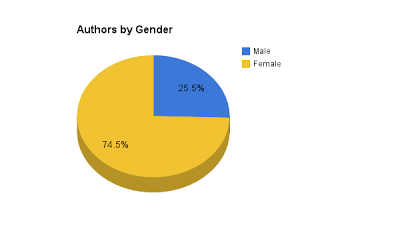
There were a total of 55 authors represented on all of the "best of lists," with 14 being male and 41 being female. In other words, roughly three-quarters of the authors this year were female, while one-quarter were male. This is a really interesting breakdown, considering that the breakdown by author gender on the New York Times Lists (in this post and this post) showed something different.
One of the comments I received on my New York Times post breakdowns was that it would be interesting to look at the main character genders in the books listed. Since I didn't look at that element in those posts, I thought I'd give it a shot with the "best of" lists this year.
As noted, there are more main characters than there are authors, so this is out of a total of 62 characters. Again, not having read all of the books, this is based on my best guesses having read through many reviews of the titles listed. I counted main characters as those who have a voice in the story. I did not include the Marcus Sedgwick book, since it is a collection of short stories and not having read it, making a call was impossible.
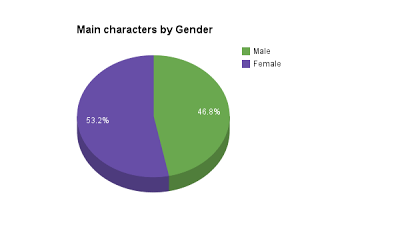 This chart tells quite a bit of a different story than the one above. Of the 62 main characters, 29 were male, and 33 were female. The percentages are much closer to even when we look at main character gender rather than look at the author's gender alone.
This chart tells quite a bit of a different story than the one above. Of the 62 main characters, 29 were male, and 33 were female. The percentages are much closer to even when we look at main character gender rather than look at the author's gender alone.
There are a couple of questions to think about with this: Did we have much better male-led stories this year? Or do we tend to take male-led stories as "better" than those led by female? This is a question I've been thinking about a lot, as it's something impossible not to think about. Female-led stories tend to have more romance in them, and it's possible we have a bias against romance. Worthwhile readings on this topic are this post and this post over at Crossreferencing.
Again, I'm making no conclusions here, but I think these are questions worth thinking about. It does make me want to revisit my NYT analysis now and look at the gender of the main character, especially as some people took problem with the fact there was more male representation when it came to author appearance on the list. I have a suspicion that looking at the gender of the main characters of those books wouldn't actually change my findings very much.
Debut Authors vs. More Seasoned Authors
What kind of break down is there between new authors and those who are on their second, fifth, or twentieth book? Are there more books by authors who've done their time on the "best of" lists or more by debut authors?
I am a purist when defining "debut." These are first books. They are not first YA books. I did not hold published short stories or poems against debut status, as long as the book on the "best of" list was the author's first novel. In other words, Alaya Dawn Johnson is not a debut author, despite The Summer Prince being her first YA book.
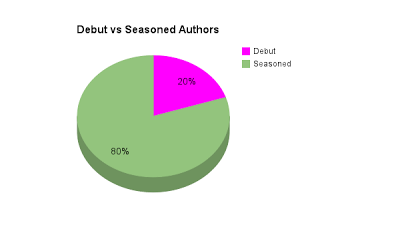 There were a total of 11 debut novels on the lists, making up 20% of the total. The other 44 novels were by authors who had previously published a novel.
There were a total of 11 debut novels on the lists, making up 20% of the total. The other 44 novels were by authors who had previously published a novel.
What about gender of the debut author?
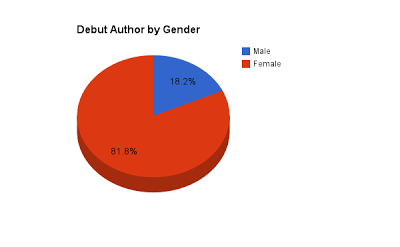 Of the 11 debut authors, nine were female and two were male.
Of the 11 debut authors, nine were female and two were male.
Continuing to talk a bit about the debut novelists who made the list, how do the Morris Shortlist authors compare? Of the five books on the Morris list, three of those books saw themselves on any of the five "best of" lists: Carrie Mesrobian's Sex & Violence, which made both Kirkus and PW's "best of" list, In The Shadow of Blackbirds by Cat Winters made SLJ's list, and Evan Roskos's Dr. Bird's Advice for Sad Poets, which made the Kirkus list. That's more than half.
"Best Of" by Genre
It's tough to decide what book belongs in what genre. There are some which could go more than one way (especially when it comes to historical and fantasy, as some could go either way easily). Again, since I haven't read all of the books on this list, I had to pull some of my decisions from reviews, as well as from talking with those who have read the book. In short: decisions are subjective, but they're based on research.
I broke down my categories as broadly as possible. Thus, "realistic" is a category and not contemporary, for the sake of putting books like Eleanor & Park into what might be the best place for it to fit. I considered Far, Far Away to be fantasy, rather than paranormal, as I determined paranormal a category best suited for a story featuring a creature, rather than a spirit. I know it's a bit arbitrary.
Did one genre do better than another this year when it came to best of lists? Let's take a look.
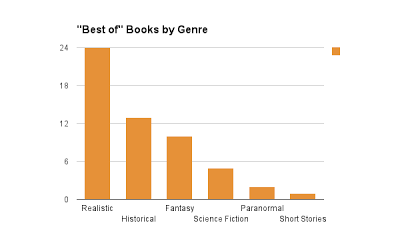
Turns out that realistic fiction led other genres in "best of" lists this year. Out of a total of 55 books, 24 were realistic fiction. Historical had 13, with fantasy 10, science fiction 5, paranormal 2, and short stories 1.
Perhaps there's something to the suggestion there has been a growth in realistic fiction this year. This is something I may try to tackle in a series of posts next week about trends in 2014 fiction because I think it's better said there might be a rise in a certain type of realistic fiction coming up.
Books by "Best of" List Frequency
How many books saw themselves on more than one "best of" list this year? Even though the staff of the journals choose their titles by vote (usually), it's always curious to be to see what trends emerge in titles that appear more than once. Do those very early lists like School Library Journal's in November influence those which appear later? Or more realistically, do awards like the National Book Award or the Horn Book/Boston Globe Book Award put titles onto radars as possible "best of" picks? What influences what, if anything?
It's worth noting here -- and I'll repeat it again in the next posts -- that the journals each choose a different number of "best of" titles. And with my criteria listed in the beginning of this post to define "YA Fiction," the number of titles eligible shifted, too. Kirkus had 42 titles, School Library Journal had 13, LJ's "YA for Adults" had 3, Horn Book had 5, and Publishers Weekly had 16. Again, I'll come back to these totals in future posts.
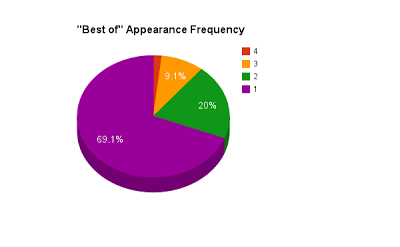 Within the five lists, there were no books which appeared on all five. Only one book saw itself on four of the lists, and that was Eleanor & Park. It did not make the "Best YA for Adults" list by SLJ, though Rowell's other book, Fangirl, did make that list.
Within the five lists, there were no books which appeared on all five. Only one book saw itself on four of the lists, and that was Eleanor & Park. It did not make the "Best YA for Adults" list by SLJ, though Rowell's other book, Fangirl, did make that list.
There were five books which appeared on three lists, eleven books which appeared on two lists, and a total of thirty-eight books which appeared on one list.
The bulk of this year's "best of" titles only showed up on one list.
"Best of" Titles by Book Format
This year seemed to be the year of novels with a twist to their format, and I think that some of the data on the "best of" list reflects that. Though this, too, is interesting to compare to last year's list. Were there any verse novels this year? What about books told with a graphic-hybridization? What about sketches or illustrations that weren't quite at graphic novel style or what about those mixed media projects?
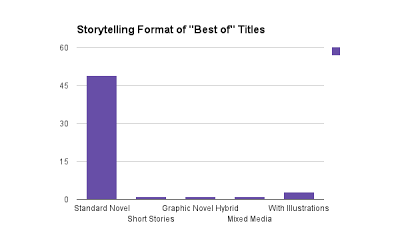
It's not surprising that standard novels made up the majority of format for storytelling. Forty-nine of the books on this list were your average novel (which isn't a means of degrading novels as "average," but rather suggesting they aren't doing anything noteworthy in format). There were three novels this year that included some kind of illustrative element to them that stood out, including Maggot Moon, Winger, and The War Within These Walls. There was on graphic novel hybrid with Chasing Shadows, one mixed media novel with In The Shadow of Blackbirds, and one short story collection, Midwinterblood.
There were no novels in verse represented this year.
Diversity and "Best Of" Lists
Two topics I wanted to look at within the "best of" lists included representation of LGBTQ and POC. Again, standard disclaimers that I haven't read all of these books, and I pulled data from my own research (as well as the linked-to blog post above from Malinda Lo).
First, let's talk about LGBTQ and the "best of" lists. How many stories featured characters whose sexuality was discussed or a major part of the book? I'm looking strictly at the books and stories, rather than authors, because it's challenging to make that determination and, I think, unfair to make it, too.
Five Books featured characters who identified as LGBTQ. These books were:
More Than This by Patrick NessThe Sin-Eater's Confession by Ilsa J. BickTwo Boys Kissing by David LevithanWinger by Andrew Smith (minor character)Zero Fade by Chris L. Terry
What about books written by or featuring people of color? This one is easier to make a determination of when it comes to author, so I'm breaking this town into two data sets: by author and by character in a book. Remember there are 55 authors and 62 main characters represented.
Authors who are POC on the "Best of" lists: 8. I did include Myers twice in the count, since he had two different books on the list.
Main characters who are POC on the "Best of" lists: 10, with one story featuring a secondary character who is a POC.
Those authors and books (some of which are written by a POC about a POC) are:
Eleanor and Park by Rainbow Rowell Zero Fade by Chris L. TerryInvasion by Walter Dean Myers Golden Boy by Tara SullivanDeath, Dickinson, and the Demented Life of Frencie Garcia by Jenny Torres-SanchezDarius & Twig by Walter Dean Myers Champion by Marie LuThe Summer Prince by Alaya Dawn JohnsonThe Counterfeit Family of Vee Crawford-Wong by L Tam HowardA Moment Comes by Jennifer BradburyChasing Shadows by Swati AvasthiYaqui Delgado Wants to Kick Your Ass by Meg Medina
Country of Origin and "Best of" Lists
I wanted to round up today's post and data by looking at something I did not look at last year, which is the country of origin of the author. Do authors who aren't from the US fair well on our "best of" lists? Do they tend to do better than US authors?
I've got three categories for this data: US born and still living in the US; foreign born and foreign living; and I have a small number of US ex-pats. Here's the breakdown:

Of the 55 authors represented on the "best of" lists, 40 were from and still living in the US. A total of 12 were foreign born and foreign living, and three were born in the US and now living in a foreign country.
There's not anything to conclude with this information, but it's interesting to see there is a fair representation of non-US authors on the list. The bulk were located in the UK, Canada, and Australia.
***
Any thoughts on the data so far? Surprises? Non-surprises?
Tomorrow there will be another post, this time looking at a number of other factors, including date of publication for the books on the lists, the spread of publishers represented on the list, and more. I'll talk about the way this year's "best of" lists compare to last year's on Thursday, since there are some interesting trends in the books on these lists.
Even if no conclusions can be made, it is always fascinating to see what a year in books looks like and what it is we define as "the best" in a year (and it's equally or more fascinating to see what's not included).
Editing to add that Malinda Lo has some really great observation and commentary about LGBTQ as represented on this year's "Best of" lists. Go check it out.






 Related StoriesNovember and December Debut YA NovelsThe To-Read PileGet Genrefied: Humor
Related StoriesNovember and December Debut YA NovelsThe To-Read PileGet Genrefied: Humor
This year, I wanted to look at a number of factors like I did last year, and it requires more than one post to do so. Because I still had all of my data from last year pulled into a single space (I did not in 2011, where all of my information was posted in another forum), I've written third post as well, comparing the data from last year against this year's. They will publish today, tomorrow, and on Thursday.
The "best of" lists I looked at this year are the same ones I analyzed last year: School Library Journal, Publishers Weekly, Kirkus, Horn Book, and the Library Journal list of Best YA for Adults. I like to look at that last one, the YA for Adults, because I think it's worth keeping an eye on and comparing with the lists that are geared less toward adults -- are there crossover titles? Are there different titles completely? It adds another flavor to the data.
Because they come out a little bit later, I have not looked at the best of lists from Booklist nor BCCB, though it's possible I may look at them comparatively in the new year (BCCB's list comes out in January and Booklist's should be out this week, either prior to this post or after it). I limited what I looked at to YA fiction only. This means no graphic novels (though if you're curious, the graphic novels which made this combination of lists include Boxers and Saints, on all five of the lists; Delilah Dirk and the Turkish Lieutenant on two of the lists; Will & Whit on one of the lists; Romeo & Juliet on one of the lists; and March on one of the lists) and I did not include non-fiction titles (of which there were very few).
I made my determination on whether a book was a YA book or not based on the criteria that Amazon listed it as a book for those age 12 and older. This meant some books which have been debated as being "for YA readers or not," like Tom McNeal's Far, Far Away, were indeed included in my count. I did not include illustrators for books that feature graphic or illustrative elements in my author counts or breakdowns.
Though more relevant to tomorrow's post than today's, I pulled my information about starred reviews from ShelfTalker's last updated "The Stars So Far" post; since this was last updated in mid-November, it's possible some of these titles may have earned additional stars since then. Information about LGBTQ representation in these books was pulled from Malinda Lo's tallying, along with notes I've made to myself on the books I have read.
Before diving in, some caveats: none of this data means anything. I'm not trying to draw conclusions nor suggest certain things about the books that popped up on the "best of" lists. Errors here in terms of counts, in my decision to list a book as featuring a POC, in my tallying of MCs by gender, and so forth, are all my own. I have not read all of these books, so sometimes, I had to make an educated guess based on reviews I read. Tomorrow, I'll link to all of my raw data in the introduction.
There were a total of 55 books on these lists, 55 authors, and a total of 62 main characters, as some books were told through more than one point of view.
With that, let's see what there is to see in this year's "Best of YA" lists.
Gender Representation in the "Best of" Lists
First, let's look at gender and the "best of" lists. Do we have more male authors represented or do we have more female authors?

There were a total of 55 authors represented on all of the "best of lists," with 14 being male and 41 being female. In other words, roughly three-quarters of the authors this year were female, while one-quarter were male. This is a really interesting breakdown, considering that the breakdown by author gender on the New York Times Lists (in this post and this post) showed something different.
One of the comments I received on my New York Times post breakdowns was that it would be interesting to look at the main character genders in the books listed. Since I didn't look at that element in those posts, I thought I'd give it a shot with the "best of" lists this year.
As noted, there are more main characters than there are authors, so this is out of a total of 62 characters. Again, not having read all of the books, this is based on my best guesses having read through many reviews of the titles listed. I counted main characters as those who have a voice in the story. I did not include the Marcus Sedgwick book, since it is a collection of short stories and not having read it, making a call was impossible.
 This chart tells quite a bit of a different story than the one above. Of the 62 main characters, 29 were male, and 33 were female. The percentages are much closer to even when we look at main character gender rather than look at the author's gender alone.
This chart tells quite a bit of a different story than the one above. Of the 62 main characters, 29 were male, and 33 were female. The percentages are much closer to even when we look at main character gender rather than look at the author's gender alone.There are a couple of questions to think about with this: Did we have much better male-led stories this year? Or do we tend to take male-led stories as "better" than those led by female? This is a question I've been thinking about a lot, as it's something impossible not to think about. Female-led stories tend to have more romance in them, and it's possible we have a bias against romance. Worthwhile readings on this topic are this post and this post over at Crossreferencing.
Again, I'm making no conclusions here, but I think these are questions worth thinking about. It does make me want to revisit my NYT analysis now and look at the gender of the main character, especially as some people took problem with the fact there was more male representation when it came to author appearance on the list. I have a suspicion that looking at the gender of the main characters of those books wouldn't actually change my findings very much.
Debut Authors vs. More Seasoned Authors
What kind of break down is there between new authors and those who are on their second, fifth, or twentieth book? Are there more books by authors who've done their time on the "best of" lists or more by debut authors?
I am a purist when defining "debut." These are first books. They are not first YA books. I did not hold published short stories or poems against debut status, as long as the book on the "best of" list was the author's first novel. In other words, Alaya Dawn Johnson is not a debut author, despite The Summer Prince being her first YA book.
 There were a total of 11 debut novels on the lists, making up 20% of the total. The other 44 novels were by authors who had previously published a novel.
There were a total of 11 debut novels on the lists, making up 20% of the total. The other 44 novels were by authors who had previously published a novel.What about gender of the debut author?
 Of the 11 debut authors, nine were female and two were male.
Of the 11 debut authors, nine were female and two were male.Continuing to talk a bit about the debut novelists who made the list, how do the Morris Shortlist authors compare? Of the five books on the Morris list, three of those books saw themselves on any of the five "best of" lists: Carrie Mesrobian's Sex & Violence, which made both Kirkus and PW's "best of" list, In The Shadow of Blackbirds by Cat Winters made SLJ's list, and Evan Roskos's Dr. Bird's Advice for Sad Poets, which made the Kirkus list. That's more than half.
"Best Of" by Genre
It's tough to decide what book belongs in what genre. There are some which could go more than one way (especially when it comes to historical and fantasy, as some could go either way easily). Again, since I haven't read all of the books on this list, I had to pull some of my decisions from reviews, as well as from talking with those who have read the book. In short: decisions are subjective, but they're based on research.
I broke down my categories as broadly as possible. Thus, "realistic" is a category and not contemporary, for the sake of putting books like Eleanor & Park into what might be the best place for it to fit. I considered Far, Far Away to be fantasy, rather than paranormal, as I determined paranormal a category best suited for a story featuring a creature, rather than a spirit. I know it's a bit arbitrary.
Did one genre do better than another this year when it came to best of lists? Let's take a look.

Turns out that realistic fiction led other genres in "best of" lists this year. Out of a total of 55 books, 24 were realistic fiction. Historical had 13, with fantasy 10, science fiction 5, paranormal 2, and short stories 1.
Perhaps there's something to the suggestion there has been a growth in realistic fiction this year. This is something I may try to tackle in a series of posts next week about trends in 2014 fiction because I think it's better said there might be a rise in a certain type of realistic fiction coming up.
Books by "Best of" List Frequency
How many books saw themselves on more than one "best of" list this year? Even though the staff of the journals choose their titles by vote (usually), it's always curious to be to see what trends emerge in titles that appear more than once. Do those very early lists like School Library Journal's in November influence those which appear later? Or more realistically, do awards like the National Book Award or the Horn Book/Boston Globe Book Award put titles onto radars as possible "best of" picks? What influences what, if anything?
It's worth noting here -- and I'll repeat it again in the next posts -- that the journals each choose a different number of "best of" titles. And with my criteria listed in the beginning of this post to define "YA Fiction," the number of titles eligible shifted, too. Kirkus had 42 titles, School Library Journal had 13, LJ's "YA for Adults" had 3, Horn Book had 5, and Publishers Weekly had 16. Again, I'll come back to these totals in future posts.
 Within the five lists, there were no books which appeared on all five. Only one book saw itself on four of the lists, and that was Eleanor & Park. It did not make the "Best YA for Adults" list by SLJ, though Rowell's other book, Fangirl, did make that list.
Within the five lists, there were no books which appeared on all five. Only one book saw itself on four of the lists, and that was Eleanor & Park. It did not make the "Best YA for Adults" list by SLJ, though Rowell's other book, Fangirl, did make that list.There were five books which appeared on three lists, eleven books which appeared on two lists, and a total of thirty-eight books which appeared on one list.
The bulk of this year's "best of" titles only showed up on one list.
"Best of" Titles by Book Format
This year seemed to be the year of novels with a twist to their format, and I think that some of the data on the "best of" list reflects that. Though this, too, is interesting to compare to last year's list. Were there any verse novels this year? What about books told with a graphic-hybridization? What about sketches or illustrations that weren't quite at graphic novel style or what about those mixed media projects?

It's not surprising that standard novels made up the majority of format for storytelling. Forty-nine of the books on this list were your average novel (which isn't a means of degrading novels as "average," but rather suggesting they aren't doing anything noteworthy in format). There were three novels this year that included some kind of illustrative element to them that stood out, including Maggot Moon, Winger, and The War Within These Walls. There was on graphic novel hybrid with Chasing Shadows, one mixed media novel with In The Shadow of Blackbirds, and one short story collection, Midwinterblood.
There were no novels in verse represented this year.
Diversity and "Best Of" Lists
Two topics I wanted to look at within the "best of" lists included representation of LGBTQ and POC. Again, standard disclaimers that I haven't read all of these books, and I pulled data from my own research (as well as the linked-to blog post above from Malinda Lo).
First, let's talk about LGBTQ and the "best of" lists. How many stories featured characters whose sexuality was discussed or a major part of the book? I'm looking strictly at the books and stories, rather than authors, because it's challenging to make that determination and, I think, unfair to make it, too.
Five Books featured characters who identified as LGBTQ. These books were:
More Than This by Patrick NessThe Sin-Eater's Confession by Ilsa J. BickTwo Boys Kissing by David LevithanWinger by Andrew Smith (minor character)Zero Fade by Chris L. Terry
What about books written by or featuring people of color? This one is easier to make a determination of when it comes to author, so I'm breaking this town into two data sets: by author and by character in a book. Remember there are 55 authors and 62 main characters represented.
Authors who are POC on the "Best of" lists: 8. I did include Myers twice in the count, since he had two different books on the list.
Main characters who are POC on the "Best of" lists: 10, with one story featuring a secondary character who is a POC.
Those authors and books (some of which are written by a POC about a POC) are:
Eleanor and Park by Rainbow Rowell Zero Fade by Chris L. TerryInvasion by Walter Dean Myers Golden Boy by Tara SullivanDeath, Dickinson, and the Demented Life of Frencie Garcia by Jenny Torres-SanchezDarius & Twig by Walter Dean Myers Champion by Marie LuThe Summer Prince by Alaya Dawn JohnsonThe Counterfeit Family of Vee Crawford-Wong by L Tam HowardA Moment Comes by Jennifer BradburyChasing Shadows by Swati AvasthiYaqui Delgado Wants to Kick Your Ass by Meg Medina
Country of Origin and "Best of" Lists
I wanted to round up today's post and data by looking at something I did not look at last year, which is the country of origin of the author. Do authors who aren't from the US fair well on our "best of" lists? Do they tend to do better than US authors?
I've got three categories for this data: US born and still living in the US; foreign born and foreign living; and I have a small number of US ex-pats. Here's the breakdown:

Of the 55 authors represented on the "best of" lists, 40 were from and still living in the US. A total of 12 were foreign born and foreign living, and three were born in the US and now living in a foreign country.
There's not anything to conclude with this information, but it's interesting to see there is a fair representation of non-US authors on the list. The bulk were located in the UK, Canada, and Australia.
***
Any thoughts on the data so far? Surprises? Non-surprises?
Tomorrow there will be another post, this time looking at a number of other factors, including date of publication for the books on the lists, the spread of publishers represented on the list, and more. I'll talk about the way this year's "best of" lists compare to last year's on Thursday, since there are some interesting trends in the books on these lists.
Even if no conclusions can be made, it is always fascinating to see what a year in books looks like and what it is we define as "the best" in a year (and it's equally or more fascinating to see what's not included).
Editing to add that Malinda Lo has some really great observation and commentary about LGBTQ as represented on this year's "Best of" lists. Go check it out.







 Related StoriesNovember and December Debut YA NovelsThe To-Read PileGet Genrefied: Humor
Related StoriesNovember and December Debut YA NovelsThe To-Read PileGet Genrefied: Humor
Published on December 09, 2013 22:00
December 8, 2013
Freakangels by Warren Ellis and Paul Duffield
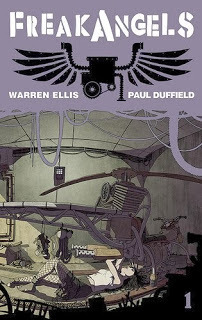 Usually I'll write my own plot synopsis for reviews, but the one on the back of the book for Warren Ellis' and Paul Duffield's comic book series Freakangels hits all the right notes, I think:
Usually I'll write my own plot synopsis for reviews, but the one on the back of the book for Warren Ellis' and Paul Duffield's comic book series Freakangels hits all the right notes, I think: 23 years ago, twelve strange children were born in England at exactly the same moment. 6 years ago, the world ended. This is the story of what happened next.
There's more to it than this, of course. Those strange children-now-adults have dubbed themselves the freakangels, and they've settled in a flooded part of London called Whitechapel. Most of them are usually focused on protecting the survivors in Whitechapel - I say "most" and "usually" because they're not always united in their goal. Complicating things is the fact that they had something to do with the cataclysm. Exactly what they did is revealed slowly, over the course of the story.
The main cast is huge, since Ellis and Duffield focus on each of the 12 freakangels at some point in the story. It's quite a feat that each is distinct, then, and doesn't become a caricature. None of them are your typical superheroes, though some of them are trying. I wouldn't even say any of them are the Robert Downey, Jr. Iron Man-type superheroes: flawed, tortured, but still larger-than-life. Rather, these people seem very much "same size as life," if you can say such a thing - they don't have the witty comebacks all the time, they can be hurt (and not just in the final showdown), they deliberately make bad choices along with good ones, over and over. The knowledge that they're somehow the cause of the suffering around them adds an important layer - and the way each freakangel deals with this knowledge is telling, too. The characters are just plain interesting, with complex relationships and personalities.
Part of what makes the series so good is the art by Duffield. I find that characters in a lot of comics - particularly those that have been ongoing for many years - blend together, even within single volumes. It forces the reader to rely on clothing choices or hairstyles to keep them straight. That's not the case with Duffield's illustrations, which are not only lovely, but also detail-rich and consistent from panel to panel. His characters are easily recognizable and diverse in appearance as well as personality. I also love the slightly muted color palette, which fits the mood of the story perfectly.
This is an adult comic with adult themes and language (frank talk of sex and lots of f-bombs), but I can certainly see it appealing to more mature teens. It feels like what a lot of the popular teen post-apocalyptic stories would be if the characters were 23 instead of 17. In fact, it could be described as an adult sequel to the YA story of what these people did as 17-year-olds. Because it's a full story contained in six easy-to-digest volumes, it's also a great series to hand to someone who may just be dipping their toes into comics. (No decades of background knowledge necessary!)
Freakangels is available in six print volumes, but it actually first appeared completely free and legal on the web: www.freakangels.com.







 Related StoriesGraphic Novel RoundupThe 100 by Kass MorganInk Is Thicker Than Water by Amy Spalding
Related StoriesGraphic Novel RoundupThe 100 by Kass MorganInk Is Thicker Than Water by Amy Spalding
Published on December 08, 2013 22:00
December 6, 2013
Our favorite books of 2013 & What we're looking forward to in 2014
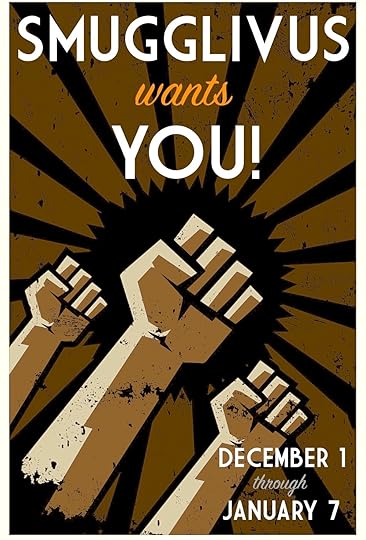
Today we're over at The Book Smugglers, taking part in their annual Smugglivus celebration. Both of us talk about our individual favorite reads in 2013, as well as the two books both of us loved this year. We also talked a little bit of television, movies, and what we're really excited about reading and seeing in the new year.
Check it out.
While you're there, make sure you check out the rest of the awesome Smugglivus posts, too. It's over a month long, so keep tuning in. I know my to-read list keeps expanding and expanding.







 Related Stories2012 in Review
Related Stories2012 in Review
Published on December 06, 2013 07:20
December 5, 2013
November and December Debut YA Novels
Since both November and December are quieter months when it comes to debut novels this year, rather than having two separate posts, I'd combine the two. This will be the last roundup of debut novels out in 2013, but you can catch up on previous posts by checking out October's debut post and working backwards from there.
Did you see this week's announcement of the YALSA Morris contenders? Check out the 5 books honored on the short list. This is probably my favorite of the awards lists, as it rewards not just a well-done debut novel, but it looks at both appeal to readers and the potential for that author to continue producing excellent work in the future.
As usual, if I've missed a traditionally-published debut novel that came out in November or will be coming out this month, let me know in the comments. All descriptions are from WorldCat, unless otherwise noted.
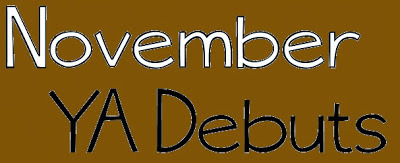
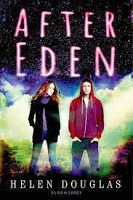
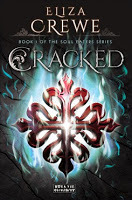
After Eden by Helen Douglas: Eden, sixteen, must choose between helping Ryan, a time-traveler, and her best friend Connor who, according to Ryan, is about to become famous through a significant scientific discovery that will, ultimately ruin the world.
Cracked by Eliza Crewe: Meet Meda. She eats people. Well, technically, she eats their soul. But she can't help being a bad guy. She knows she's different and the only other person who could have told her about other "soul-eaters" is now dead. That is, until the three men in suits show up. They can do what she can do. They're like her. Meda might finally be able to figure out what she is and why the Hunger with her for souls is growing. The problem? They want to kill her.
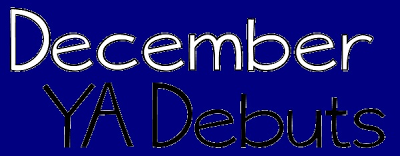
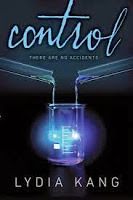
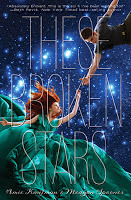
Control by Lydia Kang: In 2150, when genetic manipulation has been outlawed, seventeen-year-old Zelia must rescue her kidnapped sister with the help of a band of outcasts with mutated genes.
These Broken Stars by Aime Kaufman and Meagan Spooner: Two star-crossed lovers must fight for survival when they crash land on a seemingly uninhabited planet. Note that Kaufman is the debut author with this book, but Spooner debuted in August 2012 with Skylark.
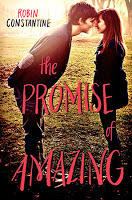
The Promise of Amazing by Robin Constantine: Wren Caswell is average. Ranked in the middle of her class at Sacred Heart, she’s not popular, but not a social misfit. Wren is the quiet, “good” girl who's always done what she's supposed to—only now in her junior year, this passive strategy is backfiring. She wants to change, but doesn’t know how. Grayson Barrett was the king of St. Gabe’s. Star of the lacrosse team, top of his class, on a fast track to a brilliant future—until he was expelled for being a “term paper pimp.” Now Gray is in a downward spiral and needs to change, but doesn’t know how. One fateful night their paths cross when Wren, working at her family’s Arthurian-themed catering hall, performs the Heimlich on Gray as he chokes on a cocktail weenie, saving his life literally and figuratively. What follows is the complicated, awkward, hilarious, and tender tale of two teens shedding their pasts, figuring out who they are—and falling in love. (via Goodreads)
Have you had any favorite debut novels this year? I'd love to know what you dug in the comments and what you're looking forward to in 2014.






 Related StoriesThe To-Read PileGet Genrefied: HumorHardcover to Paperback: Six YA Book Makeovers to Consider
Related StoriesThe To-Read PileGet Genrefied: HumorHardcover to Paperback: Six YA Book Makeovers to Consider
Did you see this week's announcement of the YALSA Morris contenders? Check out the 5 books honored on the short list. This is probably my favorite of the awards lists, as it rewards not just a well-done debut novel, but it looks at both appeal to readers and the potential for that author to continue producing excellent work in the future.
As usual, if I've missed a traditionally-published debut novel that came out in November or will be coming out this month, let me know in the comments. All descriptions are from WorldCat, unless otherwise noted.



After Eden by Helen Douglas: Eden, sixteen, must choose between helping Ryan, a time-traveler, and her best friend Connor who, according to Ryan, is about to become famous through a significant scientific discovery that will, ultimately ruin the world.
Cracked by Eliza Crewe: Meet Meda. She eats people. Well, technically, she eats their soul. But she can't help being a bad guy. She knows she's different and the only other person who could have told her about other "soul-eaters" is now dead. That is, until the three men in suits show up. They can do what she can do. They're like her. Meda might finally be able to figure out what she is and why the Hunger with her for souls is growing. The problem? They want to kill her.



Control by Lydia Kang: In 2150, when genetic manipulation has been outlawed, seventeen-year-old Zelia must rescue her kidnapped sister with the help of a band of outcasts with mutated genes.
These Broken Stars by Aime Kaufman and Meagan Spooner: Two star-crossed lovers must fight for survival when they crash land on a seemingly uninhabited planet. Note that Kaufman is the debut author with this book, but Spooner debuted in August 2012 with Skylark.

The Promise of Amazing by Robin Constantine: Wren Caswell is average. Ranked in the middle of her class at Sacred Heart, she’s not popular, but not a social misfit. Wren is the quiet, “good” girl who's always done what she's supposed to—only now in her junior year, this passive strategy is backfiring. She wants to change, but doesn’t know how. Grayson Barrett was the king of St. Gabe’s. Star of the lacrosse team, top of his class, on a fast track to a brilliant future—until he was expelled for being a “term paper pimp.” Now Gray is in a downward spiral and needs to change, but doesn’t know how. One fateful night their paths cross when Wren, working at her family’s Arthurian-themed catering hall, performs the Heimlich on Gray as he chokes on a cocktail weenie, saving his life literally and figuratively. What follows is the complicated, awkward, hilarious, and tender tale of two teens shedding their pasts, figuring out who they are—and falling in love. (via Goodreads)
Have you had any favorite debut novels this year? I'd love to know what you dug in the comments and what you're looking forward to in 2014.







 Related StoriesThe To-Read PileGet Genrefied: HumorHardcover to Paperback: Six YA Book Makeovers to Consider
Related StoriesThe To-Read PileGet Genrefied: HumorHardcover to Paperback: Six YA Book Makeovers to Consider
Published on December 05, 2013 22:00
December 4, 2013
Graphic Novel Roundup
A few snappy reviews of some graphic novels I've read lately. Descriptions are from Worldcat, followed by my own observations.
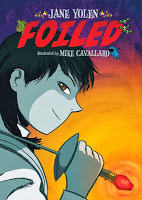
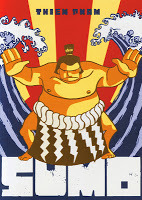
Foiled and Curses! Foiled Again by Jane Yolen and Mike Cavallaro
Aliera is a star at fencing, but at school no one notices her--until her new lab partner Avery begins flirting with her. Aliera's mother just bought her a foil from a garage sale, and it has a strange jewel attached to the hilt. Will Aliera's first date be ruined when magical creatures try to steal her foil?
I wanted to love these books. I have fond memories of Jane Yolen's novels from when I was a kid. Alas, these didn't have the same magic. There's a lot of telling, the pace is erratic, and the fantastical elements seem a bit jumbled. It should still be of interest to kids who like fencing (or are simply intrigued by it) - each section is headed with a fencing term and Aliera gets a lot of chances to use her weapon during the course of the story. (Cavallaro does an excellent job with the art; the writing doesn't meet its quality.)
Sumo by Thien Pham
Scott, abandoned by his girlfriend and having lost his dream of playing professional football, is offered a position in a Japanese sumo training "stable," where he seems to find himself again.
This is a short book that tells three parts of Scott's story in alternating times, with a different color scheme for each time. Near the end, the switches between each of the three threads become more frequent, until they converge at a single point. At that point, the images and text parallel each other. The style is effective, though it doesn't prevent the story from being a bit slight. It's gorgeous to look at - the marriage of text and art is done very well. This is a good example of the format being right for the story.
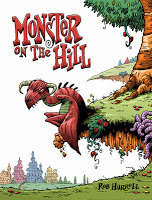
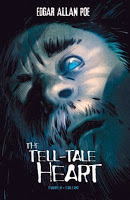
Monster on the Hill by Rob Harrell
In a fantastical 1860s England, every quiet little township is terrorized by a ferocious monster--much to the townsfolk's delight! Each town's unique monster is a source of local pride, not to mention tourism. Each town, that is-- except for one. Unfortunately, for the people of Stoker-on-Avon, their monster isn't quite as impressive. In fact, he's a little down in the dumps. Can the morose Rayburn get a monstrous makeover and become a proper horror? It's up to the eccentric Dr. Charles Wilkie and plucky street urchin Timothy to get him up to snuff, before a greater threat turns the whole town to kindling.
I loved this one. It's a light-hearted action-oriented story with a lot of humor and heart. The concept is clever and a little bit cute; I love how it's unexpected, but also plays with the idea that humans (including kids) love to be scared sometimes. It reminded me a bit of a cross between Giants Beware and the movie Monsters Inc. It's a beautiful production all around - lovely full-color art that demands to be pored over.
The Tell-Tale Heart by Edgar Allan Poe and Benjamin Harper
Retold in graphic novel form, the narrator tells the reader about the murder he committed, and the terrifying aftermath.
I'm still not quite sure if this reproduces Poe's text precisely or condenses it in some way, but the text itself isn't the creepiest part of this adaptation. That honor belongs to the art. Though it isn't quite my style, it does manage to convey a great mood. It's got lots of shadows and a color palette consisting of mainly black and some blues. The eyes of both the narrator and his victim are particularly well-done (and integral to the story).






 Related StoriesPrimates by Jim Ottaviani and Maris WicksThe 100 by Kass MorganInk Is Thicker Than Water by Amy Spalding
Related StoriesPrimates by Jim Ottaviani and Maris WicksThe 100 by Kass MorganInk Is Thicker Than Water by Amy Spalding


Foiled and Curses! Foiled Again by Jane Yolen and Mike Cavallaro
Aliera is a star at fencing, but at school no one notices her--until her new lab partner Avery begins flirting with her. Aliera's mother just bought her a foil from a garage sale, and it has a strange jewel attached to the hilt. Will Aliera's first date be ruined when magical creatures try to steal her foil?
I wanted to love these books. I have fond memories of Jane Yolen's novels from when I was a kid. Alas, these didn't have the same magic. There's a lot of telling, the pace is erratic, and the fantastical elements seem a bit jumbled. It should still be of interest to kids who like fencing (or are simply intrigued by it) - each section is headed with a fencing term and Aliera gets a lot of chances to use her weapon during the course of the story. (Cavallaro does an excellent job with the art; the writing doesn't meet its quality.)
Sumo by Thien Pham
Scott, abandoned by his girlfriend and having lost his dream of playing professional football, is offered a position in a Japanese sumo training "stable," where he seems to find himself again.
This is a short book that tells three parts of Scott's story in alternating times, with a different color scheme for each time. Near the end, the switches between each of the three threads become more frequent, until they converge at a single point. At that point, the images and text parallel each other. The style is effective, though it doesn't prevent the story from being a bit slight. It's gorgeous to look at - the marriage of text and art is done very well. This is a good example of the format being right for the story.


Monster on the Hill by Rob Harrell
In a fantastical 1860s England, every quiet little township is terrorized by a ferocious monster--much to the townsfolk's delight! Each town's unique monster is a source of local pride, not to mention tourism. Each town, that is-- except for one. Unfortunately, for the people of Stoker-on-Avon, their monster isn't quite as impressive. In fact, he's a little down in the dumps. Can the morose Rayburn get a monstrous makeover and become a proper horror? It's up to the eccentric Dr. Charles Wilkie and plucky street urchin Timothy to get him up to snuff, before a greater threat turns the whole town to kindling.
I loved this one. It's a light-hearted action-oriented story with a lot of humor and heart. The concept is clever and a little bit cute; I love how it's unexpected, but also plays with the idea that humans (including kids) love to be scared sometimes. It reminded me a bit of a cross between Giants Beware and the movie Monsters Inc. It's a beautiful production all around - lovely full-color art that demands to be pored over.
The Tell-Tale Heart by Edgar Allan Poe and Benjamin Harper
Retold in graphic novel form, the narrator tells the reader about the murder he committed, and the terrifying aftermath.
I'm still not quite sure if this reproduces Poe's text precisely or condenses it in some way, but the text itself isn't the creepiest part of this adaptation. That honor belongs to the art. Though it isn't quite my style, it does manage to convey a great mood. It's got lots of shadows and a color palette consisting of mainly black and some blues. The eyes of both the narrator and his victim are particularly well-done (and integral to the story).







 Related StoriesPrimates by Jim Ottaviani and Maris WicksThe 100 by Kass MorganInk Is Thicker Than Water by Amy Spalding
Related StoriesPrimates by Jim Ottaviani and Maris WicksThe 100 by Kass MorganInk Is Thicker Than Water by Amy Spalding
Published on December 04, 2013 22:00
December 3, 2013
The To-Read Pile
I have a little problem when it comes to my reading. I'm sure I'm not alone in it. I turn the last page on a book I thoroughly enjoyed and eagerly start my search for the next one. Except...I have a hard time finding just the right book for my mood at the time. I pick one up, set it down, pick up another. I scan the stacks at various places around the house, knowing that multiple books are calling my name, but unsure how to decide just which one is calling my name the loudest. Before I know it, I've spent an hour just wandering the house and haven't read a thing.
I'm in one of those places right now. Below are a few of the books that I'm considering as my next read, but haven't really dove into any of them yet. The first paragraphs are descriptions from Worldcat, and my own commentary follows in the second paragraphs.
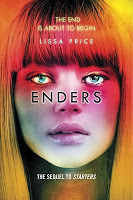
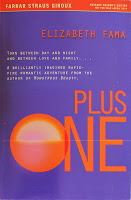
Enders by Lissa Price
With the Prime Destinations body bank destroyed, Callie no longer has to rent herself out to creepy Enders--but he can still get inside her mind and make her do things she doesn't want to do. Having the chip removed could save Callie's life -- but it could also silence the voice in her head that might belong to her father.
I dug Starters, and I hope that this sequel will prove to be just as fun as the first. I have to admit, I feel this one's call a bit stronger than the others. (I loathe this cover, though. About the same amount I loathed the cover for the first. Sigh.)
Plus One by Elizabeth Fama
In an alternate United States where Day and Night populations are forced to lead separate--but not equal--lives, a desperate Night girl falls for a seemingly privileged Day boy and places them both in danger as she gets caught up in the beginnings of a resistance movement.
I really liked Fama's previous novel, Monstrous Beauty, a nicely written historical fantasy, and this (unrelated) book sounds intriguing. The concept sounds a little far-fetched (there's no explanation given initially for the division between night and day), but I have faith the story will make me believe in it. (And as we've already discovered, it's not hard for me to suspend my disbelief.)
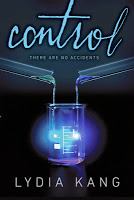
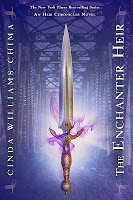
Control by Lydia Kang
In 2150, when genetic manipulation has been outlawed, seventeen-year-old Zelia must rescue her kidnapped sister with the help of a band of outcasts with mutated genes. The review copy states that Kang, a practicing physician, has "gained a reputation for helping other writers with medical accuracy in their own novels." I'm interested to see how technical this book is and how much of it is based on actual science rather than, ahem, "science."
The Enchanter Heir by Cinda Williams Chima
Racing against time, Jonah and Emma, who possess unique magical gifts, work to uncover the truth about Thorn Hill, a peaceful commune that the Wizard Guild claims is a hotbed of underguild terrorists.
I've been meaning to read Chima's fantasy novels for ages, but I've never managed to find the first in any of her series in at the library when I've remembered to look. This is the first in a duology related to the Heir Chronicles, but it's supposed to function separately, so I figure it's a good place to start.
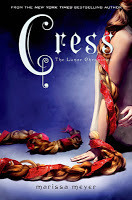
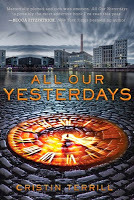
Cress by Marissa Meyer
No Worldcat summary yet, but I can tell you this is the third book in Meyer's series of futuristic fairy tale re-tellings. It's based on Rapunzel and features a girl trapped on a satellite who's become very good at hacking - and gets caught up in Cinder and Scarlet's adventures, naturally.
Some slightly tepid reviews from a few acquaintances have me holding off on this one for a while. I know I'll get around to it sooner rather than later, though.
All Our Yesterdays by Cristin Terrill
Em must travel back in time to prevent a catastrophic time machine from ever being invented, while Marina battles to prevent the murder of the boy she loves.
I love time travel, but it can be difficult to do well. When plotted right, time travel can be some of the smartest storytelling around. Reviews from people I trust indicate that Terrill does it very well here.






 Related StoriesGet Genrefied: HumorHardcover to Paperback: Six YA Book Makeovers to ConsiderThe 100 by Kass Morgan
Related StoriesGet Genrefied: HumorHardcover to Paperback: Six YA Book Makeovers to ConsiderThe 100 by Kass Morgan
I'm in one of those places right now. Below are a few of the books that I'm considering as my next read, but haven't really dove into any of them yet. The first paragraphs are descriptions from Worldcat, and my own commentary follows in the second paragraphs.


Enders by Lissa Price
With the Prime Destinations body bank destroyed, Callie no longer has to rent herself out to creepy Enders--but he can still get inside her mind and make her do things she doesn't want to do. Having the chip removed could save Callie's life -- but it could also silence the voice in her head that might belong to her father.
I dug Starters, and I hope that this sequel will prove to be just as fun as the first. I have to admit, I feel this one's call a bit stronger than the others. (I loathe this cover, though. About the same amount I loathed the cover for the first. Sigh.)
Plus One by Elizabeth Fama
In an alternate United States where Day and Night populations are forced to lead separate--but not equal--lives, a desperate Night girl falls for a seemingly privileged Day boy and places them both in danger as she gets caught up in the beginnings of a resistance movement.
I really liked Fama's previous novel, Monstrous Beauty, a nicely written historical fantasy, and this (unrelated) book sounds intriguing. The concept sounds a little far-fetched (there's no explanation given initially for the division between night and day), but I have faith the story will make me believe in it. (And as we've already discovered, it's not hard for me to suspend my disbelief.)


Control by Lydia Kang
In 2150, when genetic manipulation has been outlawed, seventeen-year-old Zelia must rescue her kidnapped sister with the help of a band of outcasts with mutated genes. The review copy states that Kang, a practicing physician, has "gained a reputation for helping other writers with medical accuracy in their own novels." I'm interested to see how technical this book is and how much of it is based on actual science rather than, ahem, "science."
The Enchanter Heir by Cinda Williams Chima
Racing against time, Jonah and Emma, who possess unique magical gifts, work to uncover the truth about Thorn Hill, a peaceful commune that the Wizard Guild claims is a hotbed of underguild terrorists.
I've been meaning to read Chima's fantasy novels for ages, but I've never managed to find the first in any of her series in at the library when I've remembered to look. This is the first in a duology related to the Heir Chronicles, but it's supposed to function separately, so I figure it's a good place to start.


Cress by Marissa Meyer
No Worldcat summary yet, but I can tell you this is the third book in Meyer's series of futuristic fairy tale re-tellings. It's based on Rapunzel and features a girl trapped on a satellite who's become very good at hacking - and gets caught up in Cinder and Scarlet's adventures, naturally.
Some slightly tepid reviews from a few acquaintances have me holding off on this one for a while. I know I'll get around to it sooner rather than later, though.
All Our Yesterdays by Cristin Terrill
Em must travel back in time to prevent a catastrophic time machine from ever being invented, while Marina battles to prevent the murder of the boy she loves.
I love time travel, but it can be difficult to do well. When plotted right, time travel can be some of the smartest storytelling around. Reviews from people I trust indicate that Terrill does it very well here.







 Related StoriesGet Genrefied: HumorHardcover to Paperback: Six YA Book Makeovers to ConsiderThe 100 by Kass Morgan
Related StoriesGet Genrefied: HumorHardcover to Paperback: Six YA Book Makeovers to ConsiderThe 100 by Kass Morgan
Published on December 03, 2013 22:00
December 2, 2013
Get Genrefied: Humor
Every month at STACKED, we're highlighting a genre or subgenre within YA literature, talking about the key elements and some of the recent offerings fitting within it. This started as part of Angela's reader's advisory challenge, and so far we've covered steampunk, horror, science fiction, high fantasy, mysteries and thrillers, verse novels, contemporary realistic, historical fiction, graphic novels, romance, and dystopia. This month, we're tackling the last and final genre, humor.
Because we have loved writing this series so much, we want to keep it going through next year, as well. We've got some ideas for genres we'd like to tackle, but included at the end of this guide, there is a very short survey asking you if there's a genre you'd like to know about so we can add it to our list of possibilities.
Humor, like horror, isn't so much a genre as it is a mood or tone of a book. Every genre can feature humor within it -- there are humorous science fiction novels, fantasy novels, horror novels, and so on. Also like horror, humor can be really dark or it can be really light. There are dark satires and there are lighter comedic romances. There's also plenty of room for humor in YA non-fiction, particularly when it comes to teen memoirs.
Humor a characteristic, and it's the sort of characteristic that is entirely subjective to the reader. What one person finds as humorous another person might not understand as funny. There are many books that have funny elements, even when they tackle a difficult subject matter. Some readers may appreciate and see it as humorous while others may see the difficult topic tackled as setting the tone of the book instead. An entire book doesn't need to be knee-slapping funny to be considered humorous: it just needs to have moments of funny within it to fit as humorous.
Jennifer Brannon notes in her guide to humor at Novelist, humor is both subjective and situational. It depends on the reader's mood as much as the reader's sense of humor, as well as the situation and subjective views of the characters in the story being read. But on the most basic level, humor just makes someone laugh.
There are surprisingly few resources available on the topic of humor in YA fiction, and part of the reason is because it's such a subjective aspect of a novel. That doesn't mean that appreciation for humor doesn't exist at all; readers and reviews often point out when a book is funny, and there are authors who can be pretty easily pointed to as those who frequently pen humorous stories. A few resources worth knowing about or keeping an eye on though:
Humor Writers of America: though their website is bare bones, this new organization is meant to be a gathering spot for those who do write humor. One of the founders, Adam Selzer, may be familiar. He's written a few YA books, including the humorous I Kissed a Zombie and I Liked It. The site has a small directory of current members, which might be helpful in scoping out some new names in humor writing.The Society of Children's Book Writers and Illustrators offers an annual award for its members who write humor called the Sid Fleischman Humor Award. The SCBWI keeps a record of those who've received the award on their website.As of this writing, there isn't a specific category for YA humor, but the Thurber House presents the annual Thurber Prize for American Humor. Molly Wetta developed this awesome flow chart to YA-friendly humor, which is well worth having on hand for readers who "want to read something funny," but might not be able to explain exactly what they're looking for in a funny book.
Here's a look at the wide-range of humor in YA fiction. As you likely remember, last month we did a big roundup of contemporary YA fiction featuring humor, which was kicked off with a guest post from author Maurene Goo on why it is she writes and appreciates funny in her stories. I've left those authors and titles off this round up and instead focused at humor across a variety of genres. All descriptions come from WorldCat, and I've tried to stick to books published in the last few years. Feel free to jump in with other titles and authors whose books would fit with humor.
Some authors to have on your radar for those seeking a funny YA book include Meg Cabot, Carl Hiaasen, Lemony Snicket, David Lubar, Louise Rennison, Ally Carter, Gordon Korman, and Josh Berk. You'd also do well handing over Douglas Adams, who has great crossover appeal and humor that translates.
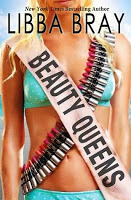
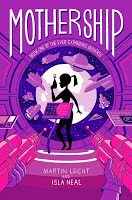
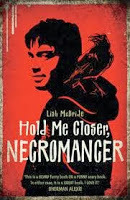
Beauty Queens by Libba Bray: When a plane crash strands thirteen teen beauty contestants on a mysterious island, they struggle to survive, to get along with one another, to combat the island's other diabolical occupants, and to learn their dance numbers in case they are rescued in time for the competition.
Mothership by Martin Leicht and Isla Neal (first in series): In 2074, while attending the Hanover School for Expecting Teen Mothers aboard an earth-orbiting spaceship, sixteen-year-old Elvie finds herself in the middle of an alien race war and makes a startling discovery about her pregnancy.
Hold Me Closer, Necromancer by Lish McBride: Sam LaCroix, a Seattle fast-food worker and college dropout, discovers that he is a necromancer, part of a world of harbingers, werewolves, satyrs, and one particular necromancer who sees Sam as a threat to his lucrative business of raising the dead.
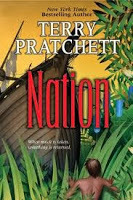
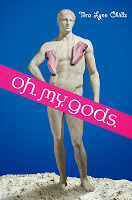
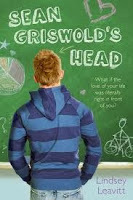
Nation by Terry Pratchett: After a devastating tsunami destroys all that they have ever known, Mau, an island boy, and Daphne, an aristocratic English girl, together with a small band of refugees, set about rebuilding their community and all the things that are important in their lives.
Oh. My. Gods. by Tera Lynn Childs: When her mother suddenly decides to marry a near-stranger, Phoebe, whose passion is running, soon finds herself living on a remote Greek island, completing her senior year at an ancient high school where the students and teachers are all descended from gods or goddesses.
Sean Griswold's Head by Lindsey Leavitt: After discovering that her father has multiple sclerosis, fifteen-year-old Payton begins counseling sessions at school, which lead her to become interested in a boy in her biology class, have a falling out with her best friend, develop an interest in bike riding, and eventually allow her to come to terms with life's uncertainties.
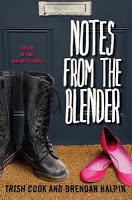
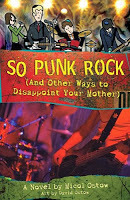
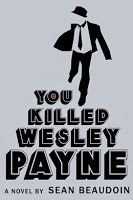
Notes From the Blender by Trish Cook and Brendan Halpin: Two teenagers--a heavy-metal-music-loving boy who is still mourning the death of his mother years earlier, and a beautiful, popular girl whose parents divorced because her father is gay--try to negotiate the complications of family and peer relationships as they get to know each other after learning that their father and mother are marrying each other.
So Punk Rock (And Other Ways to Disappoint Your Mother) by Micol Ostow: Four suburban New Jersey students from the Leo R. Gittleman Jewish Day School form a rock band that becomes inexplicably popular, creating exhiliration, friction, confrontation, and soul-searching among its members.
You Killed Wesley Payne by Sean Beaudoin: When hard-boiled, seventeen-year-old private investigator Dalton Rev transfers to Salt River High to solve the case of a dead student, he has his hands full trying to outwit the police, negotiate the school's social hierarchy, and get paid.
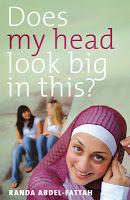
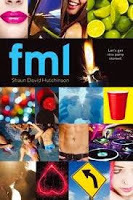
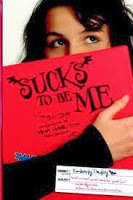
Does My Head Look Big In This? by Randa Abdel-Fattah: Year Eleven at an exclusive prep school in the suburbs of Melbourne, Australia, would be tough enough, but it is further complicated for Amal when she decides to wear the hijab, the Muslim head scarf, full-time as a badge of her faith--without losing her identity or sense of style.
fml by Shaun David Hutchinson: At a party near the end of senior year, seventeen-year-old Simon Cross imagines his life with and without Cassie, the girl he has yearned for since they were freshman, and begins to discover the unpredictable wonders of life his best friends, Ben and Coop, have urged him to explore.
Sucks to Be Me by Kimberly Pauley (also the sequel): When sixteen-year-old Mina is forced to take a class to help her decide whether or not to become a vampire like her parents, she also faces a choice between her life-long best friend and the boy she has a crush on versus new friends and possible boyfriends in her mandatory "vampire lessons."
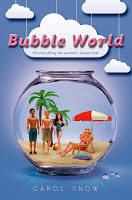
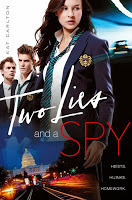
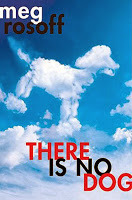
Bubble World by Carol Snow: After sixteen-year-old Fresia learns--and tells her friends--that their perfect life on a luxurious tropical island is not real, she is banished from her virtual world to the "mainland," where people are ugly, school is hard, and families are dysfunctional.
Two Lies and a Spy by Kat Carlton: Sixteen-year-old Kari juggles saving her spy parents while impressing the guy she has been in love with forever.
There is No Dog by Meg Rosoff: When the beautiful Lucy prays to fall in love, God, an irresponsible youth named Bob, chooses to answer her prayer personally, to the dismay of this assistant, Mr. B who must try to clean up the resulting catastrophes.
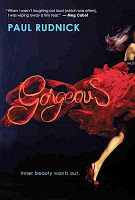
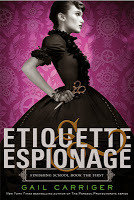
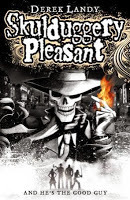
Gorgeous by Paul Rudnick: When eighteen-year-old Becky Randle's mother dies, she is whisked away from a trailer park to New York City, where fashion designer Tom Kelly offers to transform her into a glamorous Rebecca, a girl fit for a prince--but soon she begins to fear that she will lose touch with her real self.
Etiquette & Espionage by Gail Carriger: In an alternate England of 1851, spirited fourteen-year-old Sophronia is enrolled in a finishing school where, she is suprised to learn, lessons include not only the fine arts of dance, dress, and etiquette, but also diversion, deceit, and espionage.
Skulduggery Pleasant by Derek Landy: When twelve-year-old Stephanie inherits her weird uncle's estate, she must join forces with Skulduggery Pleasant, a skeleton mage, to save the world from the Faceless Ones. (This one skews middle grade.)
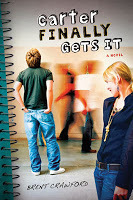
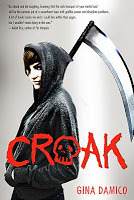
Carter Finally Gets It by Brent Crawford: Awkward freshman Will Carter endures many painful moments during his first year of high school before realizing that nothing good comes easily, focus is everything, and the payoff is usually incredible.
Croak by Gina Damico: A delinquent sixteen-year-old girl is sent to live with her uncle for the summer, only to learn that he is a Grim Reaper who wants to teach her the family business.
***
We'd love to know if there are genres (or moods, like humor) our readers are interested in having us write guides to in 2014. Should we stick to big genres or is there an interest in subgenres? Some of the ones we've got in mind to cover include urban fiction, urban fantasy, inspirational fiction, non-fiction, fairy tale retellings, satires, and westerns. Let us below know if any of these are of interest and/or what else you'd love to know more about that we haven't already covered.
Loading...






 Related StoriesHardcover to Paperback: Six YA Book Makeovers to ConsiderThe 100 by Kass MorganInk Is Thicker Than Water by Amy Spalding
Related StoriesHardcover to Paperback: Six YA Book Makeovers to ConsiderThe 100 by Kass MorganInk Is Thicker Than Water by Amy Spalding
Because we have loved writing this series so much, we want to keep it going through next year, as well. We've got some ideas for genres we'd like to tackle, but included at the end of this guide, there is a very short survey asking you if there's a genre you'd like to know about so we can add it to our list of possibilities.
Humor, like horror, isn't so much a genre as it is a mood or tone of a book. Every genre can feature humor within it -- there are humorous science fiction novels, fantasy novels, horror novels, and so on. Also like horror, humor can be really dark or it can be really light. There are dark satires and there are lighter comedic romances. There's also plenty of room for humor in YA non-fiction, particularly when it comes to teen memoirs.
Humor a characteristic, and it's the sort of characteristic that is entirely subjective to the reader. What one person finds as humorous another person might not understand as funny. There are many books that have funny elements, even when they tackle a difficult subject matter. Some readers may appreciate and see it as humorous while others may see the difficult topic tackled as setting the tone of the book instead. An entire book doesn't need to be knee-slapping funny to be considered humorous: it just needs to have moments of funny within it to fit as humorous.
Jennifer Brannon notes in her guide to humor at Novelist, humor is both subjective and situational. It depends on the reader's mood as much as the reader's sense of humor, as well as the situation and subjective views of the characters in the story being read. But on the most basic level, humor just makes someone laugh.
There are surprisingly few resources available on the topic of humor in YA fiction, and part of the reason is because it's such a subjective aspect of a novel. That doesn't mean that appreciation for humor doesn't exist at all; readers and reviews often point out when a book is funny, and there are authors who can be pretty easily pointed to as those who frequently pen humorous stories. A few resources worth knowing about or keeping an eye on though:
Humor Writers of America: though their website is bare bones, this new organization is meant to be a gathering spot for those who do write humor. One of the founders, Adam Selzer, may be familiar. He's written a few YA books, including the humorous I Kissed a Zombie and I Liked It. The site has a small directory of current members, which might be helpful in scoping out some new names in humor writing.The Society of Children's Book Writers and Illustrators offers an annual award for its members who write humor called the Sid Fleischman Humor Award. The SCBWI keeps a record of those who've received the award on their website.As of this writing, there isn't a specific category for YA humor, but the Thurber House presents the annual Thurber Prize for American Humor. Molly Wetta developed this awesome flow chart to YA-friendly humor, which is well worth having on hand for readers who "want to read something funny," but might not be able to explain exactly what they're looking for in a funny book.
Here's a look at the wide-range of humor in YA fiction. As you likely remember, last month we did a big roundup of contemporary YA fiction featuring humor, which was kicked off with a guest post from author Maurene Goo on why it is she writes and appreciates funny in her stories. I've left those authors and titles off this round up and instead focused at humor across a variety of genres. All descriptions come from WorldCat, and I've tried to stick to books published in the last few years. Feel free to jump in with other titles and authors whose books would fit with humor.
Some authors to have on your radar for those seeking a funny YA book include Meg Cabot, Carl Hiaasen, Lemony Snicket, David Lubar, Louise Rennison, Ally Carter, Gordon Korman, and Josh Berk. You'd also do well handing over Douglas Adams, who has great crossover appeal and humor that translates.



Beauty Queens by Libba Bray: When a plane crash strands thirteen teen beauty contestants on a mysterious island, they struggle to survive, to get along with one another, to combat the island's other diabolical occupants, and to learn their dance numbers in case they are rescued in time for the competition.
Mothership by Martin Leicht and Isla Neal (first in series): In 2074, while attending the Hanover School for Expecting Teen Mothers aboard an earth-orbiting spaceship, sixteen-year-old Elvie finds herself in the middle of an alien race war and makes a startling discovery about her pregnancy.
Hold Me Closer, Necromancer by Lish McBride: Sam LaCroix, a Seattle fast-food worker and college dropout, discovers that he is a necromancer, part of a world of harbingers, werewolves, satyrs, and one particular necromancer who sees Sam as a threat to his lucrative business of raising the dead.



Nation by Terry Pratchett: After a devastating tsunami destroys all that they have ever known, Mau, an island boy, and Daphne, an aristocratic English girl, together with a small band of refugees, set about rebuilding their community and all the things that are important in their lives.
Oh. My. Gods. by Tera Lynn Childs: When her mother suddenly decides to marry a near-stranger, Phoebe, whose passion is running, soon finds herself living on a remote Greek island, completing her senior year at an ancient high school where the students and teachers are all descended from gods or goddesses.
Sean Griswold's Head by Lindsey Leavitt: After discovering that her father has multiple sclerosis, fifteen-year-old Payton begins counseling sessions at school, which lead her to become interested in a boy in her biology class, have a falling out with her best friend, develop an interest in bike riding, and eventually allow her to come to terms with life's uncertainties.



Notes From the Blender by Trish Cook and Brendan Halpin: Two teenagers--a heavy-metal-music-loving boy who is still mourning the death of his mother years earlier, and a beautiful, popular girl whose parents divorced because her father is gay--try to negotiate the complications of family and peer relationships as they get to know each other after learning that their father and mother are marrying each other.
So Punk Rock (And Other Ways to Disappoint Your Mother) by Micol Ostow: Four suburban New Jersey students from the Leo R. Gittleman Jewish Day School form a rock band that becomes inexplicably popular, creating exhiliration, friction, confrontation, and soul-searching among its members.
You Killed Wesley Payne by Sean Beaudoin: When hard-boiled, seventeen-year-old private investigator Dalton Rev transfers to Salt River High to solve the case of a dead student, he has his hands full trying to outwit the police, negotiate the school's social hierarchy, and get paid.



Does My Head Look Big In This? by Randa Abdel-Fattah: Year Eleven at an exclusive prep school in the suburbs of Melbourne, Australia, would be tough enough, but it is further complicated for Amal when she decides to wear the hijab, the Muslim head scarf, full-time as a badge of her faith--without losing her identity or sense of style.
fml by Shaun David Hutchinson: At a party near the end of senior year, seventeen-year-old Simon Cross imagines his life with and without Cassie, the girl he has yearned for since they were freshman, and begins to discover the unpredictable wonders of life his best friends, Ben and Coop, have urged him to explore.
Sucks to Be Me by Kimberly Pauley (also the sequel): When sixteen-year-old Mina is forced to take a class to help her decide whether or not to become a vampire like her parents, she also faces a choice between her life-long best friend and the boy she has a crush on versus new friends and possible boyfriends in her mandatory "vampire lessons."



Bubble World by Carol Snow: After sixteen-year-old Fresia learns--and tells her friends--that their perfect life on a luxurious tropical island is not real, she is banished from her virtual world to the "mainland," where people are ugly, school is hard, and families are dysfunctional.
Two Lies and a Spy by Kat Carlton: Sixteen-year-old Kari juggles saving her spy parents while impressing the guy she has been in love with forever.
There is No Dog by Meg Rosoff: When the beautiful Lucy prays to fall in love, God, an irresponsible youth named Bob, chooses to answer her prayer personally, to the dismay of this assistant, Mr. B who must try to clean up the resulting catastrophes.



Gorgeous by Paul Rudnick: When eighteen-year-old Becky Randle's mother dies, she is whisked away from a trailer park to New York City, where fashion designer Tom Kelly offers to transform her into a glamorous Rebecca, a girl fit for a prince--but soon she begins to fear that she will lose touch with her real self.
Etiquette & Espionage by Gail Carriger: In an alternate England of 1851, spirited fourteen-year-old Sophronia is enrolled in a finishing school where, she is suprised to learn, lessons include not only the fine arts of dance, dress, and etiquette, but also diversion, deceit, and espionage.
Skulduggery Pleasant by Derek Landy: When twelve-year-old Stephanie inherits her weird uncle's estate, she must join forces with Skulduggery Pleasant, a skeleton mage, to save the world from the Faceless Ones. (This one skews middle grade.)


Carter Finally Gets It by Brent Crawford: Awkward freshman Will Carter endures many painful moments during his first year of high school before realizing that nothing good comes easily, focus is everything, and the payoff is usually incredible.
Croak by Gina Damico: A delinquent sixteen-year-old girl is sent to live with her uncle for the summer, only to learn that he is a Grim Reaper who wants to teach her the family business.
***
We'd love to know if there are genres (or moods, like humor) our readers are interested in having us write guides to in 2014. Should we stick to big genres or is there an interest in subgenres? Some of the ones we've got in mind to cover include urban fiction, urban fantasy, inspirational fiction, non-fiction, fairy tale retellings, satires, and westerns. Let us below know if any of these are of interest and/or what else you'd love to know more about that we haven't already covered.
Loading...







 Related StoriesHardcover to Paperback: Six YA Book Makeovers to ConsiderThe 100 by Kass MorganInk Is Thicker Than Water by Amy Spalding
Related StoriesHardcover to Paperback: Six YA Book Makeovers to ConsiderThe 100 by Kass MorganInk Is Thicker Than Water by Amy Spalding
Published on December 02, 2013 22:00
December 1, 2013
Hardcover to Paperback: Six YA Book Makeovers to Consider
Let's do another round of hardcover to paperback makeovers, shall we? Every season, it's fun to see what books are getting new looks, but it's even more interesting to wonder whether the new covers nail the story better than the original. As usual, some of these are great changes and some definitely are not.
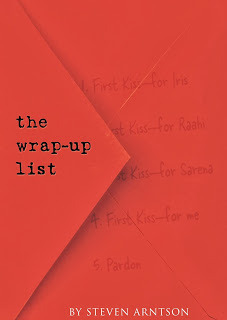
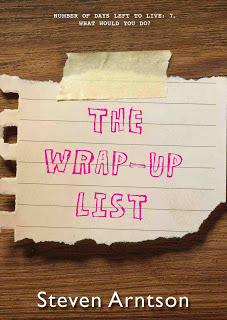
I picked up a copy of Steven Arntson's The Wrap-Up List quite a while ago but never got around to reading it. I love the envelope cover, which is the initial hardcover look. It's a really simplistic design, but it tells the reader quire a bit about the story. It's gender-neutral, and it looks like the kind of book that could have good readership across age groups because there's not a person on there nor is there an image that could be dated. But the argument here could be the exact opposite of what I've said: because it's so simplistic a cover, it maybe doesn't tell you anything about the story or about the intended audience of it. It's possible that's why I haven't picked it up yet -- I don't know whether it'd fit whatever reading mood I'm in because I don't know what it's about. It's not necessarily iconic nor memorable.
The paperback redesign on the right is also simplistic, but the addition of the tag line actually adds a lot to explaining what the story is about. This is a story about someone coming to terms with the end of their life! The wrap-up list then likely refers to the things they're hoping to "wrap up" before they don't have the time to do so any longer. The paperback also seems to "age" the book into a category a little bit more, too: it's a torn piece of notebook paper, and the title itself is handwritten in pen. The note looks like it's taped on the top of a student test. It's a book meant for teen readers.
For me, this is a pretty even exchange. I think the paperback better targets the readership, but I don't think either one is necessarily bad nor is either one outstanding. The Wrap-up List will be out in paperback from Houghton Mifflin Harcourt in paperback on May 13, 2014.
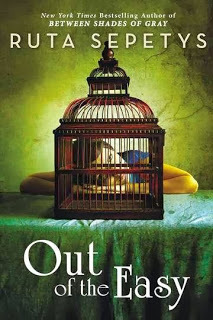
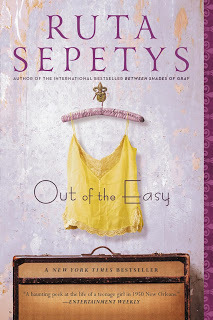
One of the things that made Out of the Easy's hardcover stand out to me was the color. It's a couple of shades of really stand-out green, and it's easy to spot on shelves. The cover image itself isn't necessarily the most memorable, though. The girl looking at the bird cage fits the story (in a metaphoric sense), but I don't know if it's an iconic cover overall. It does, however, say this is a YA book. What's interesting to pay attention to on the hardcover is what's pulled out. The author's name is large and noticeable, as is the title. But what caught my eye was that it notes she's a New York Times Bestselling author. Hold that for a minute.
The paperback redesign, available March 4, does nothing for me. It reminds me a lot of an adult fiction novel, perhaps something literary or perhaps something geared toward female readers -- I don't want to call it chick lit nor women's fiction, but that's the vibe of the cover I'm getting. It's kind of boring and forgettable in a way that the hardcover edition isn't. It's faded out, and even the lone hanging shirt and suitcase to me say something about the forgettable quality of the image. Check out, though, how the title and author treatments are different on the paperback: Ruta's name is much larger and more noticeable, as she takes up two lines and nearly 1/3 of the real estate on the cover. The title, in contrast, is very small and positioned in such a way it's easy to overlook. Rather than having Ruta called out as a NYT Bestseller by her name, she's noted instead as an internationally best selling author (though the NYT recognition comes, too, just later on on the cover). And then there's a blurb from Entertainment Weekly, too. For me, this cover is angled specifically at adult readers, rather than teen readers. It has a big name publication giving it acclaim, two notes of the author's sales capabilities, and a cover that looks somewhat generic and inoffensive.
For me, the hardcover is much stronger than the paperback here for YA readers. Though for adult readers, I suspect the paperback is more appealing.
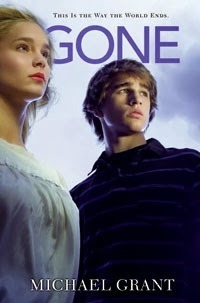
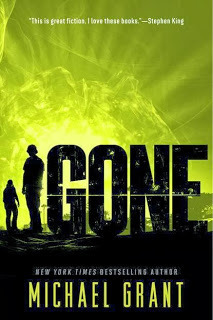
Michael Grant's Gone series is getting a new makeover in paperback. Right now, the paperback editions of the hardcover books have the same cover, but with the publication of the final book in the series, the paperbacks are going in a new direction. So on the left, the hardcover edition of Gone, the first in the series. It's a fairly generic -- and I'll even say unattractive -- cover. Two people looking in the distances. They don't really have anything memorable about them. But I'd say if anything, the original cover is gender neutral, even if it doesn't tell you anything about the book itself. There is a tagline on the hardcover, "This is the way the world ends," but that tag line in the original paperback edition changes. It's instead a pull quote from a Booklist review. Later books in the series don't have a tag line, but a pull quote from Stephen King.
I note the Stephen King pull quote because in the new paperback edition, shown on the right, it's there but easy to miss. The white font sort of fades into the bright coloring of the background. For the most part, I dig this makeover. It's gender neutral in the same way that the original covers are, but it gets rid of the people who are on it. And while I think they're gender neutral, part of me wonders if the makeover helps give these books even more boy appeal than they originally had: they look more like action novels than they do Serious Stories with people on the front. Also worth noting that Grant's name is much bigger on the new paperbacks, as is his distinction as a New York Times Bestseller.
For me, the new paperbacks are winners here. I think they're much more appealing and they stand out. The other covers look like any number of other series (think Kevin Emerson's series, for one).
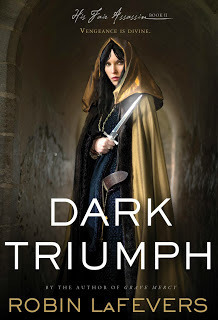
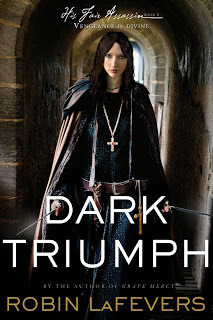
To a cover makeover I don't get at all: Robin LaFevers's Dark Triumph. On the left, the original cover. I know very little about the time setting and story here, aside from what Kimberly's written, so I don't know about accuracy or relevancy to the story. But I know so much that this cover fits very well with the cover for the first book in the series, Grave Mercy. I like the tag line "Vengeance is divine," and I like that this series has done a really good job of noting that it's part of the His Fair Assassin series. It's a very small detail, but it's something worth its weight in a library setting for readers, as well as for those who help readers but may not be familiar with YA books. Overall, the cover on the left just fits.
But the paperback is getting a different look -- but it's a very small different look. The title and author treatments are identical, as are the tag line and noting of the series at the top of the cover. What's changed is that the girl in the image is no longer looking from the side out, but she's instead looking straight on at the reader. She's not wearing a head covering, but instead, her hair is hanging down and loose. She doesn't necessarily look like she belongs in a period in history in this cover. She looks very modern. Even somewhat goth. Rather than have her dagger to her chest, she's now got it pointed out. This is a very action-oriented cover in the way that the other image is not. What's interesting, too, is how the background's changed. There's light behind her in the paperback, where there is nothing but a closed space in the hardcover.
This isn't a bad makeover in the least. I like that the designers took care to keep the style so similar that it won't look weird when paired with Grave Mercy, which has not received a makeover in paperback form. But I can't help wondering why the change? Was there something in the text that makes the paperback more true to the story than the hardcover? If anyone has read this one and wants to weigh in -- whether one is a better and more truer design than the other -- I'd love to know. Perhaps it has to do with historical accuracy?
The paperback edition of Dark Triumph will be available April 1.
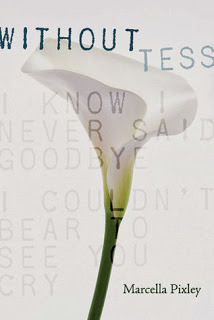
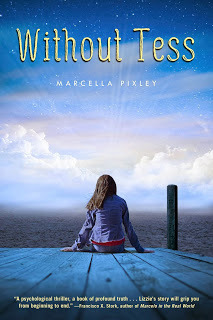
It feels like I read Without Tess by Marcella Pixley a long time ago, and when I go back into my reviews, it turns out that I read and reviewed this one in September 2011. The hardcover on the left is very quiet, and I think it reflects the story quite well. I really like the title treatment and the use of the words and font down the front. They stand in place of any kind of tag line or blurb. The author's name is small and in the corner, but it's not hard to see and it stands out in dark gray against the stark white of the rest of the cover.
Of course, the quiet cover means that it doesn't stand out on a shelf, nor does it necessarily give the reader any insight into what the story is about. But there is something to be considered about how the cover conveys tone very well here.
The paperback of Without Tess will release May 13, 2014, which is quite a long time between the initial publication in hardcover in 2011. Like the original, the cover here is also quiet, but it seems to be a different kind of quiet. This cover reflects the content a little bit more, and it portrays the sense of loss in a way that the flower and handful of words do not in the original. There's been an addition of a blurb from Francisco X. Stork on the cover, which I think is a really nice name to have giving Pixley's book some props -- readers who dig the kind of quiet story Stork writes will likely find this one to be a good read. What I don't like about the paperback, though, is the title font treatment. The color is right but I think that the font itself looks very young, casting this much more as a middle grade novel than as a young adult. Maybe it's my screen resolution, but it looks as though there are small white lines aiming up toward the font, too, which only furthers the juvenile feeling. I also note that Pixley's name is done in a thin, white font that is easy to miss with the blue background.
I think the hardcover of this book is much stronger, but I wouldn't be surprised if the paperback has more appeal to a wider range of readers.
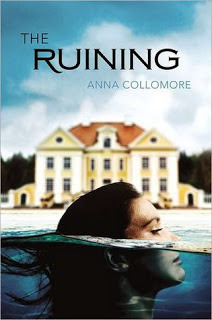

Anna Collomore's psychological thriller The Ruining came out earlier this year with the cover on the left. It's an eye-catching one: there's the girl half underwater with the massive mansion in the back. It's a neat contrast and a nice metaphor. I feel like this is quite a memorable cover because it's so different. There's not a blurb nor is there a tag line on the original cover. The title and the author's name are done in pretty standard fonts that don't detract from the greater image.
The paperback edition of Collomore's The Ruining will be available February 6, 2014. And it's completely different than the original cover: there's a closeup of a girl who looks way, way older than a teenager. She's clearly upset about something, and she looks slightly off. It's a memorable facial expression, for sure. There's a girl in the background, too, though little could be said about her expression nor of her body language because she's so far back. Is she turning a light switch on or off? Is she just holding the wall to stay standing up? I like the pop of yellow and white that the wall brings to the cover, and I think that the pink used for the author's name stands out nicely, too. But the title itself seems to get lost in this image in a way that doesn't make the image stand out. It's just easy to overlook. There's a pull quote from a Kirkus review, too: "gripping stuff." I don't know how much that tells anyone anything about the book, nor do I think it helps give the cover something new or different, either.
It feels like this cover isn't aimed at teen readers. It looks like the kind of cover you'd find in the adult section, and it's really possible the target is adult readers here. If the girl looked younger, perhaps I'd feel differently. But she doesn't look like she's a teen. She also looks heavily photoshopped (unless that's just my computer's screen resolution). Either way, the new paperback doesn't stand out to me and it's easily forgettable in a way that the hardcover isn't. You wouldn't know this is a psychological thriller.
Hardcover wins this one, hands down.
So of the covers above, what do you think? Which ones are winners and which ones could have stuck to the original and been better?







 Related StoriesHardcover to Paperback: Five to Check Out& Titled: Ampersands in YA FictionHardcover to Paperback: Five Changes to Check Out
Related StoriesHardcover to Paperback: Five to Check Out& Titled: Ampersands in YA FictionHardcover to Paperback: Five Changes to Check Out


I picked up a copy of Steven Arntson's The Wrap-Up List quite a while ago but never got around to reading it. I love the envelope cover, which is the initial hardcover look. It's a really simplistic design, but it tells the reader quire a bit about the story. It's gender-neutral, and it looks like the kind of book that could have good readership across age groups because there's not a person on there nor is there an image that could be dated. But the argument here could be the exact opposite of what I've said: because it's so simplistic a cover, it maybe doesn't tell you anything about the story or about the intended audience of it. It's possible that's why I haven't picked it up yet -- I don't know whether it'd fit whatever reading mood I'm in because I don't know what it's about. It's not necessarily iconic nor memorable.
The paperback redesign on the right is also simplistic, but the addition of the tag line actually adds a lot to explaining what the story is about. This is a story about someone coming to terms with the end of their life! The wrap-up list then likely refers to the things they're hoping to "wrap up" before they don't have the time to do so any longer. The paperback also seems to "age" the book into a category a little bit more, too: it's a torn piece of notebook paper, and the title itself is handwritten in pen. The note looks like it's taped on the top of a student test. It's a book meant for teen readers.
For me, this is a pretty even exchange. I think the paperback better targets the readership, but I don't think either one is necessarily bad nor is either one outstanding. The Wrap-up List will be out in paperback from Houghton Mifflin Harcourt in paperback on May 13, 2014.


One of the things that made Out of the Easy's hardcover stand out to me was the color. It's a couple of shades of really stand-out green, and it's easy to spot on shelves. The cover image itself isn't necessarily the most memorable, though. The girl looking at the bird cage fits the story (in a metaphoric sense), but I don't know if it's an iconic cover overall. It does, however, say this is a YA book. What's interesting to pay attention to on the hardcover is what's pulled out. The author's name is large and noticeable, as is the title. But what caught my eye was that it notes she's a New York Times Bestselling author. Hold that for a minute.
The paperback redesign, available March 4, does nothing for me. It reminds me a lot of an adult fiction novel, perhaps something literary or perhaps something geared toward female readers -- I don't want to call it chick lit nor women's fiction, but that's the vibe of the cover I'm getting. It's kind of boring and forgettable in a way that the hardcover edition isn't. It's faded out, and even the lone hanging shirt and suitcase to me say something about the forgettable quality of the image. Check out, though, how the title and author treatments are different on the paperback: Ruta's name is much larger and more noticeable, as she takes up two lines and nearly 1/3 of the real estate on the cover. The title, in contrast, is very small and positioned in such a way it's easy to overlook. Rather than having Ruta called out as a NYT Bestseller by her name, she's noted instead as an internationally best selling author (though the NYT recognition comes, too, just later on on the cover). And then there's a blurb from Entertainment Weekly, too. For me, this cover is angled specifically at adult readers, rather than teen readers. It has a big name publication giving it acclaim, two notes of the author's sales capabilities, and a cover that looks somewhat generic and inoffensive.
For me, the hardcover is much stronger than the paperback here for YA readers. Though for adult readers, I suspect the paperback is more appealing.


Michael Grant's Gone series is getting a new makeover in paperback. Right now, the paperback editions of the hardcover books have the same cover, but with the publication of the final book in the series, the paperbacks are going in a new direction. So on the left, the hardcover edition of Gone, the first in the series. It's a fairly generic -- and I'll even say unattractive -- cover. Two people looking in the distances. They don't really have anything memorable about them. But I'd say if anything, the original cover is gender neutral, even if it doesn't tell you anything about the book itself. There is a tagline on the hardcover, "This is the way the world ends," but that tag line in the original paperback edition changes. It's instead a pull quote from a Booklist review. Later books in the series don't have a tag line, but a pull quote from Stephen King.
I note the Stephen King pull quote because in the new paperback edition, shown on the right, it's there but easy to miss. The white font sort of fades into the bright coloring of the background. For the most part, I dig this makeover. It's gender neutral in the same way that the original covers are, but it gets rid of the people who are on it. And while I think they're gender neutral, part of me wonders if the makeover helps give these books even more boy appeal than they originally had: they look more like action novels than they do Serious Stories with people on the front. Also worth noting that Grant's name is much bigger on the new paperbacks, as is his distinction as a New York Times Bestseller.
For me, the new paperbacks are winners here. I think they're much more appealing and they stand out. The other covers look like any number of other series (think Kevin Emerson's series, for one).


To a cover makeover I don't get at all: Robin LaFevers's Dark Triumph. On the left, the original cover. I know very little about the time setting and story here, aside from what Kimberly's written, so I don't know about accuracy or relevancy to the story. But I know so much that this cover fits very well with the cover for the first book in the series, Grave Mercy. I like the tag line "Vengeance is divine," and I like that this series has done a really good job of noting that it's part of the His Fair Assassin series. It's a very small detail, but it's something worth its weight in a library setting for readers, as well as for those who help readers but may not be familiar with YA books. Overall, the cover on the left just fits.
But the paperback is getting a different look -- but it's a very small different look. The title and author treatments are identical, as are the tag line and noting of the series at the top of the cover. What's changed is that the girl in the image is no longer looking from the side out, but she's instead looking straight on at the reader. She's not wearing a head covering, but instead, her hair is hanging down and loose. She doesn't necessarily look like she belongs in a period in history in this cover. She looks very modern. Even somewhat goth. Rather than have her dagger to her chest, she's now got it pointed out. This is a very action-oriented cover in the way that the other image is not. What's interesting, too, is how the background's changed. There's light behind her in the paperback, where there is nothing but a closed space in the hardcover.
This isn't a bad makeover in the least. I like that the designers took care to keep the style so similar that it won't look weird when paired with Grave Mercy, which has not received a makeover in paperback form. But I can't help wondering why the change? Was there something in the text that makes the paperback more true to the story than the hardcover? If anyone has read this one and wants to weigh in -- whether one is a better and more truer design than the other -- I'd love to know. Perhaps it has to do with historical accuracy?
The paperback edition of Dark Triumph will be available April 1.


It feels like I read Without Tess by Marcella Pixley a long time ago, and when I go back into my reviews, it turns out that I read and reviewed this one in September 2011. The hardcover on the left is very quiet, and I think it reflects the story quite well. I really like the title treatment and the use of the words and font down the front. They stand in place of any kind of tag line or blurb. The author's name is small and in the corner, but it's not hard to see and it stands out in dark gray against the stark white of the rest of the cover.
Of course, the quiet cover means that it doesn't stand out on a shelf, nor does it necessarily give the reader any insight into what the story is about. But there is something to be considered about how the cover conveys tone very well here.
The paperback of Without Tess will release May 13, 2014, which is quite a long time between the initial publication in hardcover in 2011. Like the original, the cover here is also quiet, but it seems to be a different kind of quiet. This cover reflects the content a little bit more, and it portrays the sense of loss in a way that the flower and handful of words do not in the original. There's been an addition of a blurb from Francisco X. Stork on the cover, which I think is a really nice name to have giving Pixley's book some props -- readers who dig the kind of quiet story Stork writes will likely find this one to be a good read. What I don't like about the paperback, though, is the title font treatment. The color is right but I think that the font itself looks very young, casting this much more as a middle grade novel than as a young adult. Maybe it's my screen resolution, but it looks as though there are small white lines aiming up toward the font, too, which only furthers the juvenile feeling. I also note that Pixley's name is done in a thin, white font that is easy to miss with the blue background.
I think the hardcover of this book is much stronger, but I wouldn't be surprised if the paperback has more appeal to a wider range of readers.


Anna Collomore's psychological thriller The Ruining came out earlier this year with the cover on the left. It's an eye-catching one: there's the girl half underwater with the massive mansion in the back. It's a neat contrast and a nice metaphor. I feel like this is quite a memorable cover because it's so different. There's not a blurb nor is there a tag line on the original cover. The title and the author's name are done in pretty standard fonts that don't detract from the greater image.
The paperback edition of Collomore's The Ruining will be available February 6, 2014. And it's completely different than the original cover: there's a closeup of a girl who looks way, way older than a teenager. She's clearly upset about something, and she looks slightly off. It's a memorable facial expression, for sure. There's a girl in the background, too, though little could be said about her expression nor of her body language because she's so far back. Is she turning a light switch on or off? Is she just holding the wall to stay standing up? I like the pop of yellow and white that the wall brings to the cover, and I think that the pink used for the author's name stands out nicely, too. But the title itself seems to get lost in this image in a way that doesn't make the image stand out. It's just easy to overlook. There's a pull quote from a Kirkus review, too: "gripping stuff." I don't know how much that tells anyone anything about the book, nor do I think it helps give the cover something new or different, either.
It feels like this cover isn't aimed at teen readers. It looks like the kind of cover you'd find in the adult section, and it's really possible the target is adult readers here. If the girl looked younger, perhaps I'd feel differently. But she doesn't look like she's a teen. She also looks heavily photoshopped (unless that's just my computer's screen resolution). Either way, the new paperback doesn't stand out to me and it's easily forgettable in a way that the hardcover isn't. You wouldn't know this is a psychological thriller.
Hardcover wins this one, hands down.
So of the covers above, what do you think? Which ones are winners and which ones could have stuck to the original and been better?







 Related StoriesHardcover to Paperback: Five to Check Out& Titled: Ampersands in YA FictionHardcover to Paperback: Five Changes to Check Out
Related StoriesHardcover to Paperback: Five to Check Out& Titled: Ampersands in YA FictionHardcover to Paperback: Five Changes to Check Out
Published on December 01, 2013 22:00



